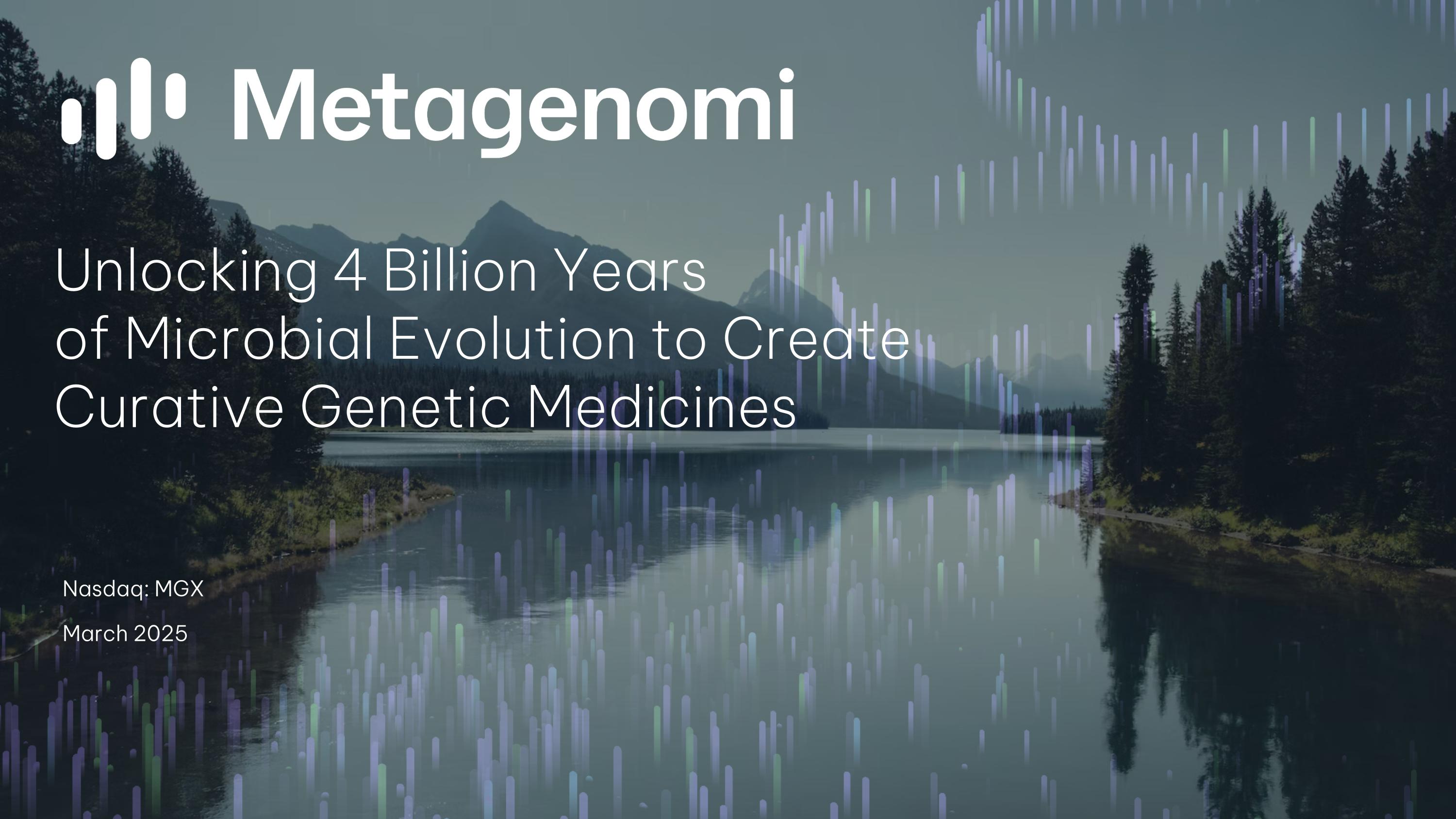

Nasdaq: MGX March 2025 Unlocking 4 Billion Years of Microbial Evolution to Create Curative Genetic Medicines
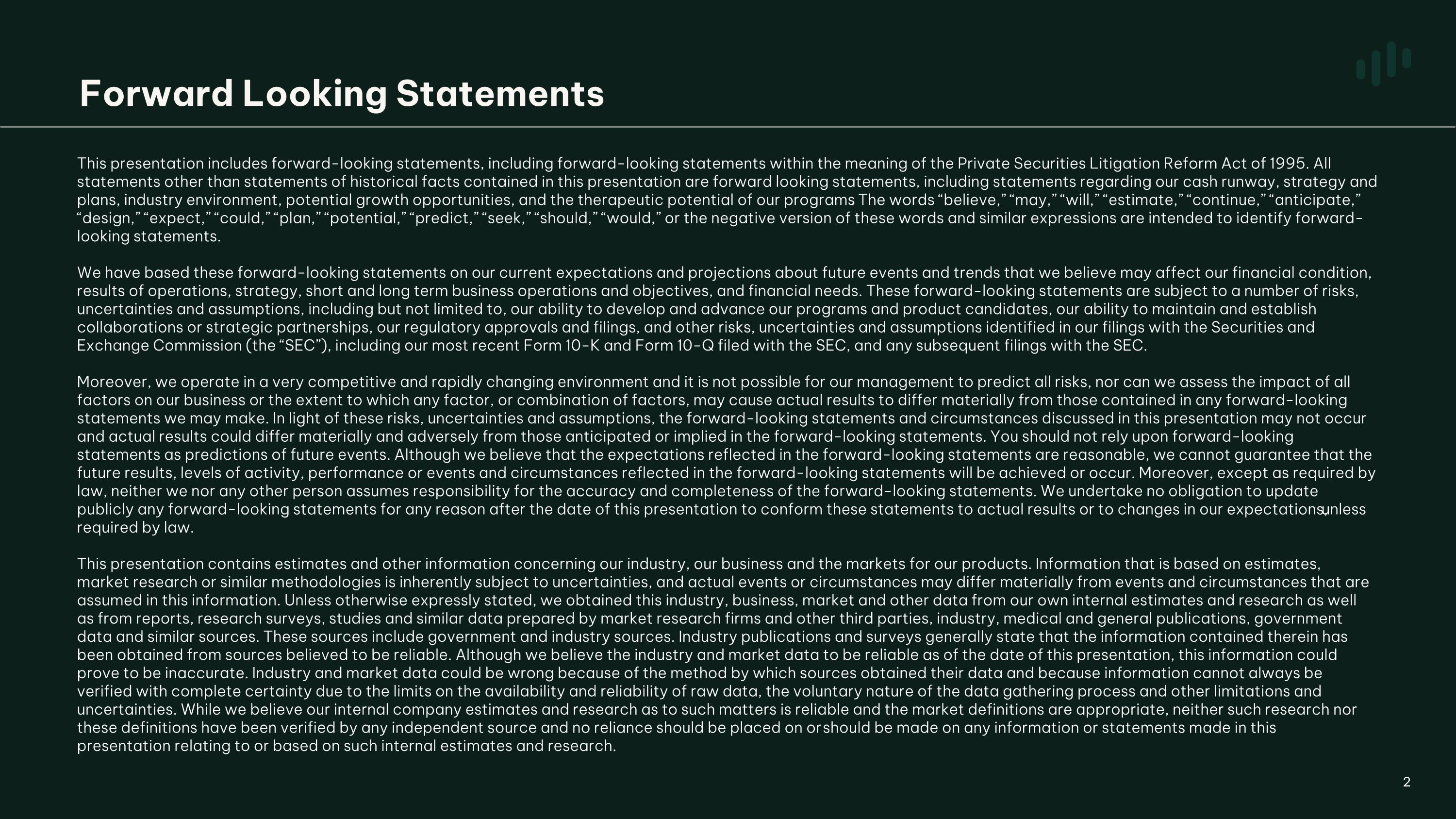
Forward Looking Statements This presentation includes forward-looking statements, including forward-looking statements within the meaning of the Private Securities Litigation Reform Act of 1995. All statements other than statements of historical facts contained in this presentation are forward looking statements, including statements regarding our cash runway, strategy and plans, industry environment, potential growth opportunities, and the therapeutic potential of our programs. The words “believe,” “may,” “will,” “estimate,” “continue,” “anticipate,” “design,” “expect,” “could,” “plan,” “potential,” “predict,” “seek,” “should,” “would,” or the negative version of these words and similar expressions are intended to identify forward-looking statements. We have based these forward-looking statements on our current expectations and projections about future events and trends that we believe may affect our financial condition, results of operations, strategy, short and long term business operations and objectives, and financial needs. These forward-looking statements are subject to a number of risks, uncertainties and assumptions, including but not limited to, our ability to develop and advance our programs and product candidates, our ability to maintain and establish collaborations or strategic partnerships, our regulatory approvals and filings, and other risks, uncertainties and assumptions identified in our filings with the Securities and Exchange Commission (the “SEC”), including our most recent Form 10-K and Form 10-Q filed with the SEC, and any subsequent filings with the SEC. Moreover, we operate in a very competitive and rapidly changing environment and it is not possible for our management to predict all risks, nor can we assess the impact of all factors on our business or the extent to which any factor, or combination of factors, may cause actual results to differ materially from those contained in any forward-looking statements we may make. In light of these risks, uncertainties and assumptions, the forward-looking statements and circumstances discussed in this presentation may not occur and actual results could differ materially and adversely from those anticipated or implied in the forward-looking statements. You should not rely upon forward-looking statements as predictions of future events. Although we believe that the expectations reflected in the forward-looking statements are reasonable, we cannot guarantee that the future results, levels of activity, performance or events and circumstances reflected in the forward-looking statements will be achieved or occur. Moreover, except as required by law, neither we nor any other person assumes responsibility for the accuracy and completeness of the forward-looking statements. We undertake no obligation to update publicly any forward-looking statements for any reason after the date of this presentation to conform these statements to actual results or to changes in our expectations, unless required by law. This presentation contains estimates and other information concerning our industry, our business and the markets for our products. Information that is based on estimates, market research or similar methodologies is inherently subject to uncertainties, and actual events or circumstances may differ materially from events and circumstances that are assumed in this information. Unless otherwise expressly stated, we obtained this industry, business, market and other data from our own internal estimates and research as well as from reports, research surveys, studies and similar data prepared by market research firms and other third parties, industry, medical and general publications, government data and similar sources. These sources include government and industry sources. Industry publications and surveys generally state that the information contained therein has been obtained from sources believed to be reliable. Although we believe the industry and market data to be reliable as of the date of this presentation, this information could prove to be inaccurate. Industry and market data could be wrong because of the method by which sources obtained their data and because information cannot always be verified with complete certainty due to the limits on the availability and reliability of raw data, the voluntary nature of the data gathering process and other limitations and uncertainties. While we believe our internal company estimates and research as to such matters is reliable and the market definitions are appropriate, neither such research nor these definitions have been verified by any independent source and no reliance should be placed on or should be made on any information or statements made in this presentation relating to or based on such internal estimates and research. 2
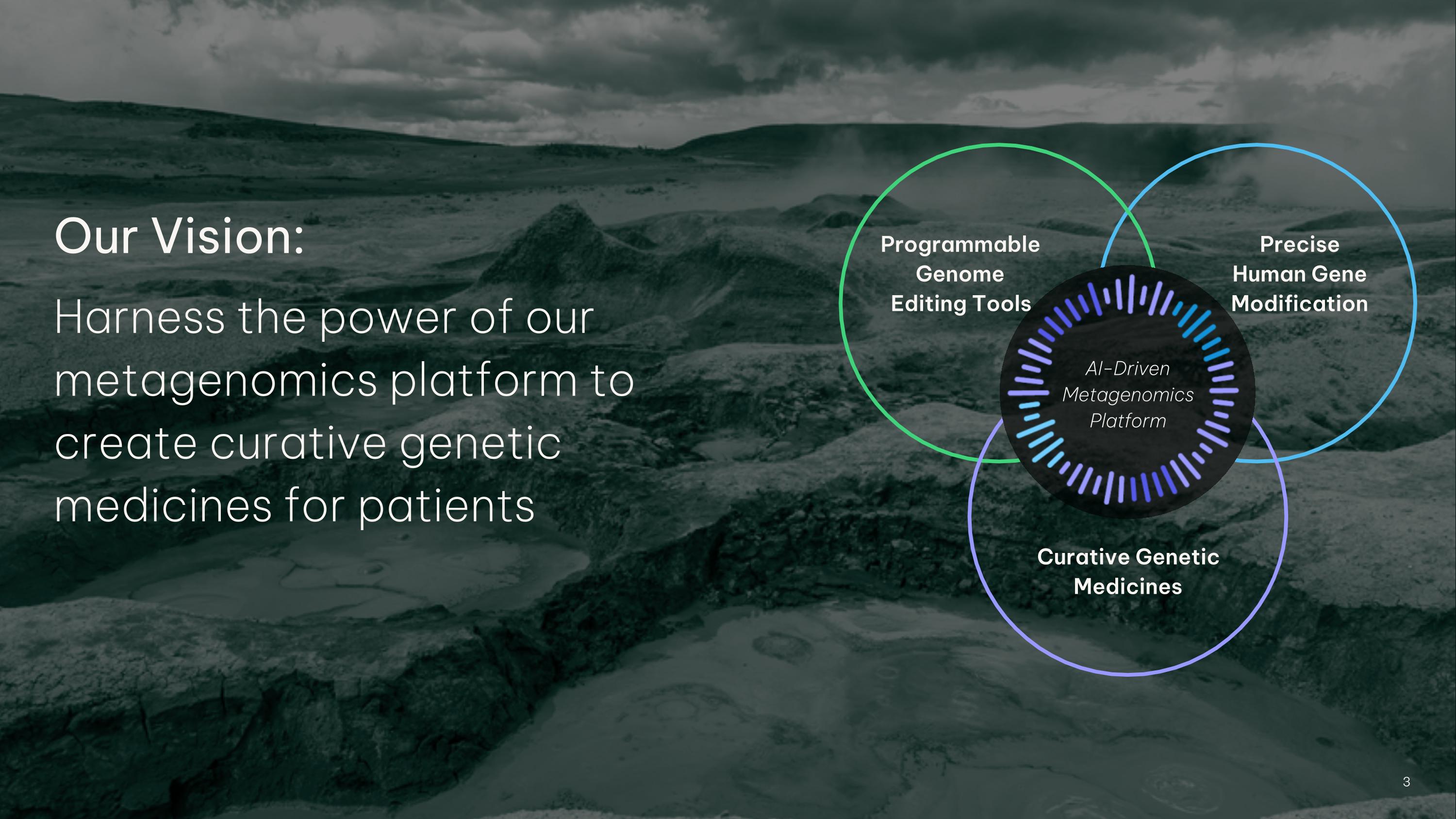
Our Vision: Harness the power of our metagenomics platform to create curative genetic medicines for patients Programmable Genome Editing Tools Precise Human Gene Modification Curative Genetic Medicines AI-Driven Metagenomics Platform
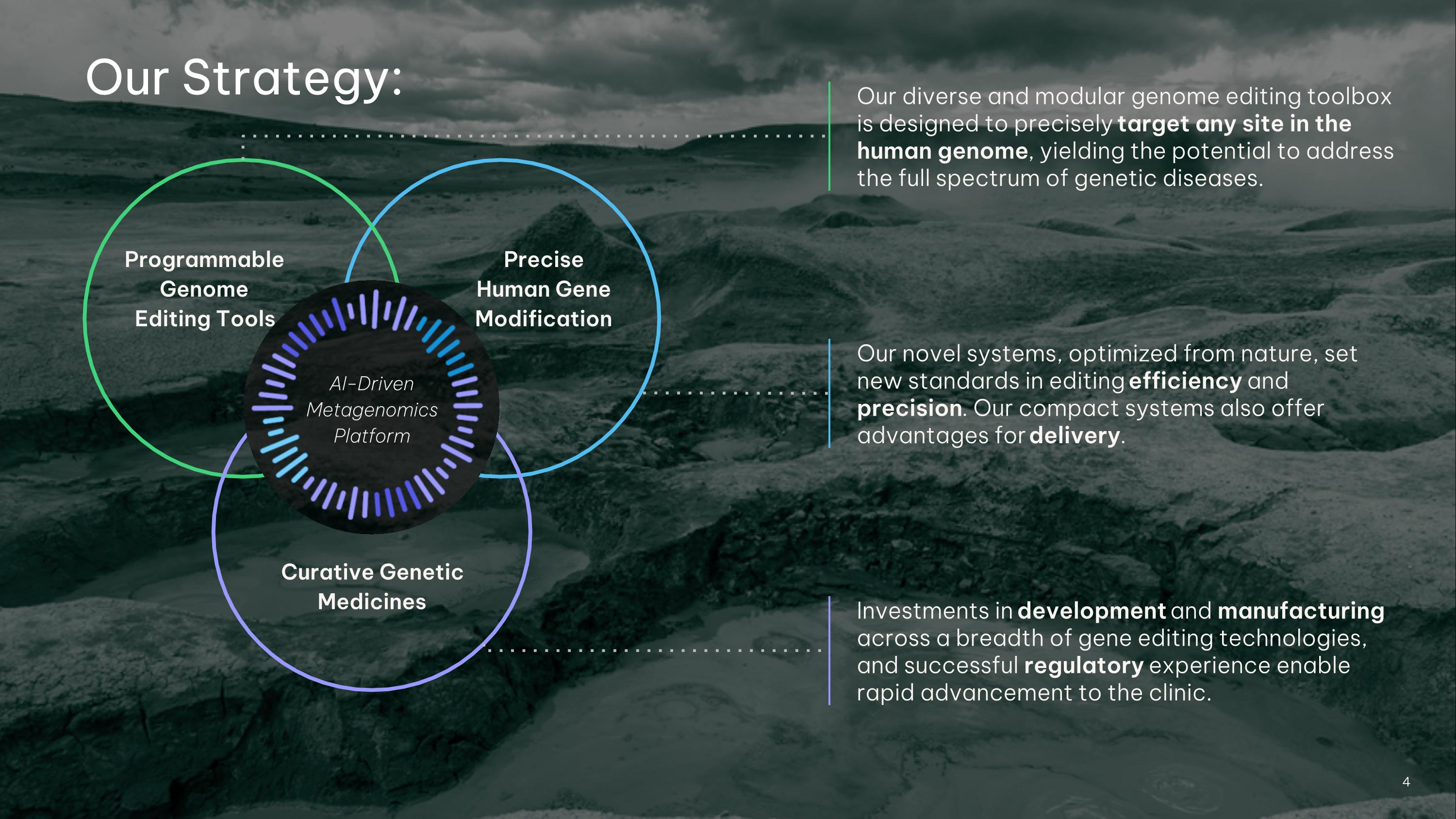
Programmable Genome Editing Tools AI-Driven Metagenomics Platform Precise Human Gene Modification Curative Genetic Medicines Our diverse and modular genome editing toolbox is designed to precisely target any site in the human genome, yielding the potential to address the full spectrum of genetic diseases. Our novel systems, optimized from nature, set new standards in editing efficiency and precision. Our compact systems also offer advantages for delivery. Investments in development and manufacturing across a breadth of gene editing technologies, and successful regulatory experience enable rapid advancement to the clinic. Our Strategy:
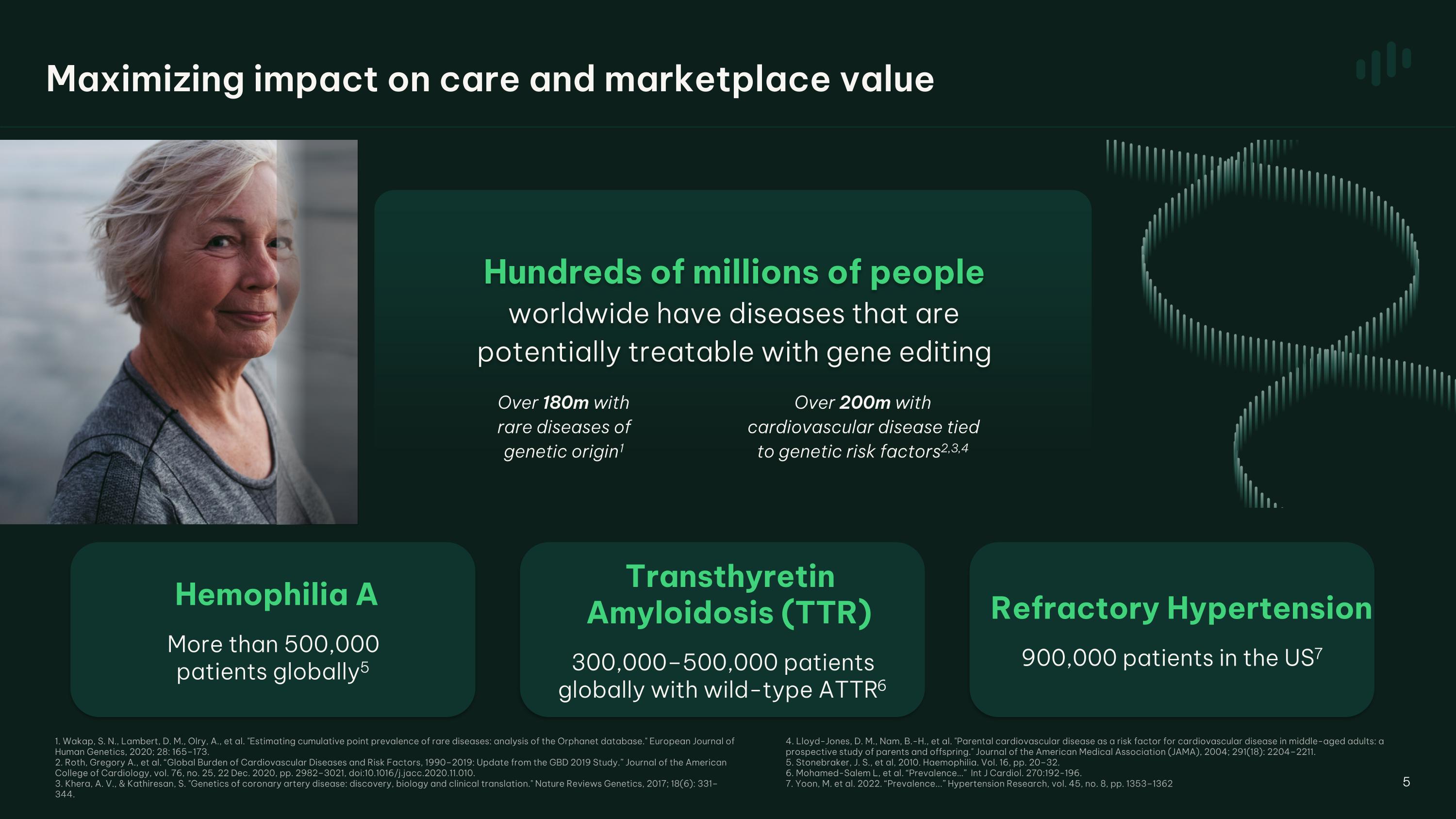
Hemophilia A More than 500,000 patients globally 5 Refractory Hypertension 900,000 patients in the US 7 Transthyretin Amyloidosis (TTR) 300,000–500,000 patients globally with wild-type ATTR 6 Hundreds of millions of people worldwide have diseases that are potentially treatable with gene editing Over 180m with rare diseases of genetic origin 1 Over 200m with cardiovascular disease tied to genetic risk factors 2,3,4 1. Wakap, S. N., Lambert, D. M., Olry, A., et al. "Estimating cumulative point prevalence of rare diseases: analysis of the Orphanet database." European Journal of Human Genetics, 2020; 28: 165–173. 2. Roth, Gregory A., et al. “Global Burden of Cardiovascular Diseases and Risk Factors, 1990–2019: Update from the GBD 2019 Study.” Journal of the American College of Cardiology, vol. 76, no. 25, 22 Dec. 2020, pp. 2982–3021, doi:10.1016/j.jacc.2020.11.010. 3. Khera, A. V., & Kathiresan, S. "Genetics of coronary artery disease: discovery, biology and clinical translation." Nature Reviews Genetics, 2017; 18(6): 331–344. 4. Lloyd-Jones, D. M., Nam, B.-H., et al. "Parental cardiovascular disease as a risk factor for cardiovascular disease in middle-aged adults: a prospective study of parents and offspring." Journal of the American Medical Association (JAMA), 2004; 291(18): 2204–2211. 5. Stonebraker, J. S., et al, 2010. Haemophilia. Vol. 16, pp. 20–32. 6. Mohamed-Salem L, et al. “Prevalence…” Int J Cardiol. 270:192-196. 7. Yoon, M. et al. 2022. “Prevalence...” Hypertension Research, vol. 45, no. 8, pp. 1353–1362 Maximizing impact on care and marketplace value
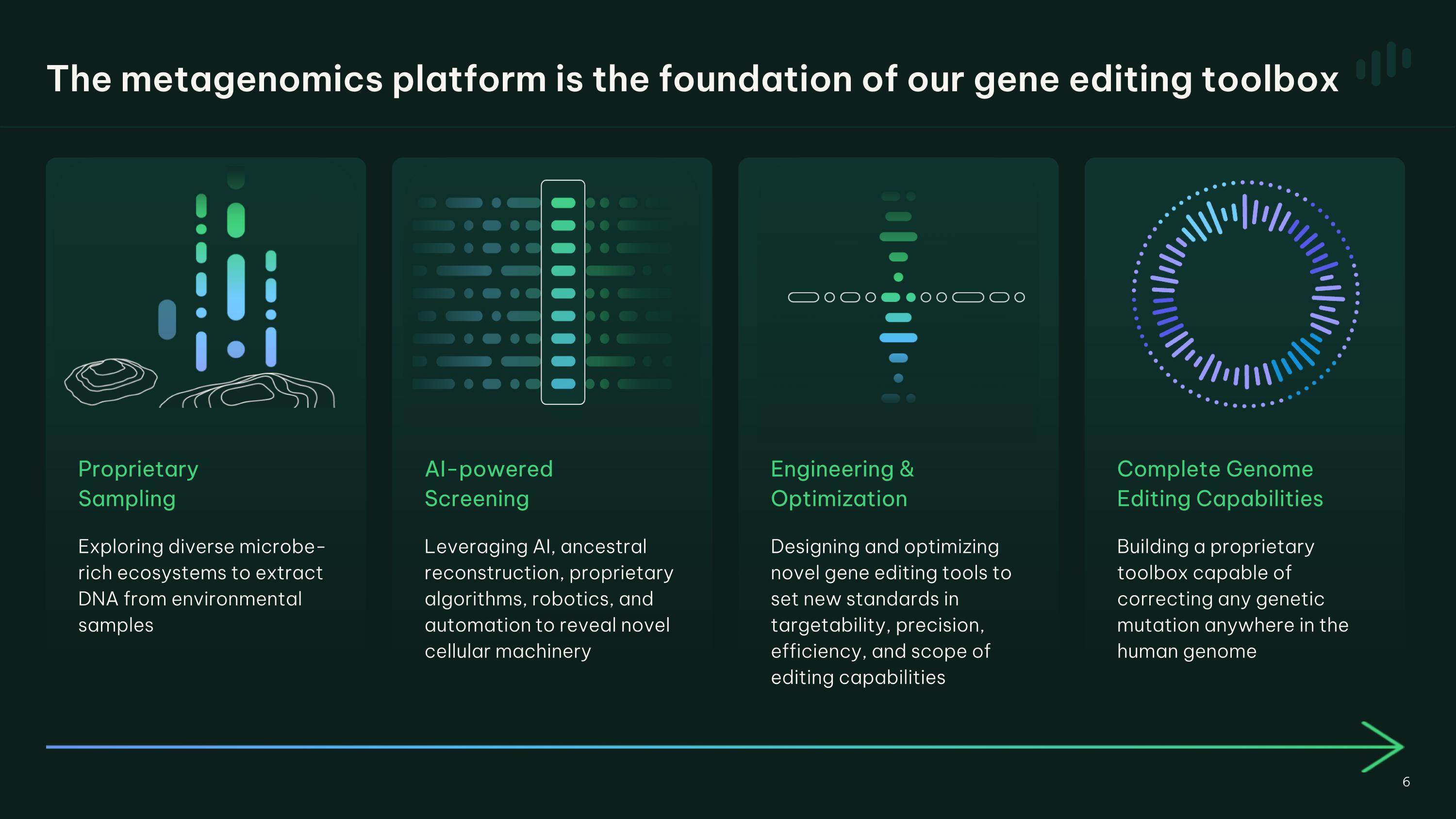
Proprietary Sampling Exploring diverse microbe- rich ecosystems to extract DNA from environmental samples AI-powered Screening Leveraging AI, ancestral reconstruction, proprietary algorithms, robotics, and automation to reveal novel cellular machinery Complete Genome Editing Capabilities Building a proprietary toolbox capable of correcting any genetic mutation anywhere in the human genome Engineering & Optimization Designing and optimizing novel gene editing tools to set new standards in targetability, precision, efficiency, and scope of editing capabilities The metagenomics platform is the foundation of our gene editing toolbox
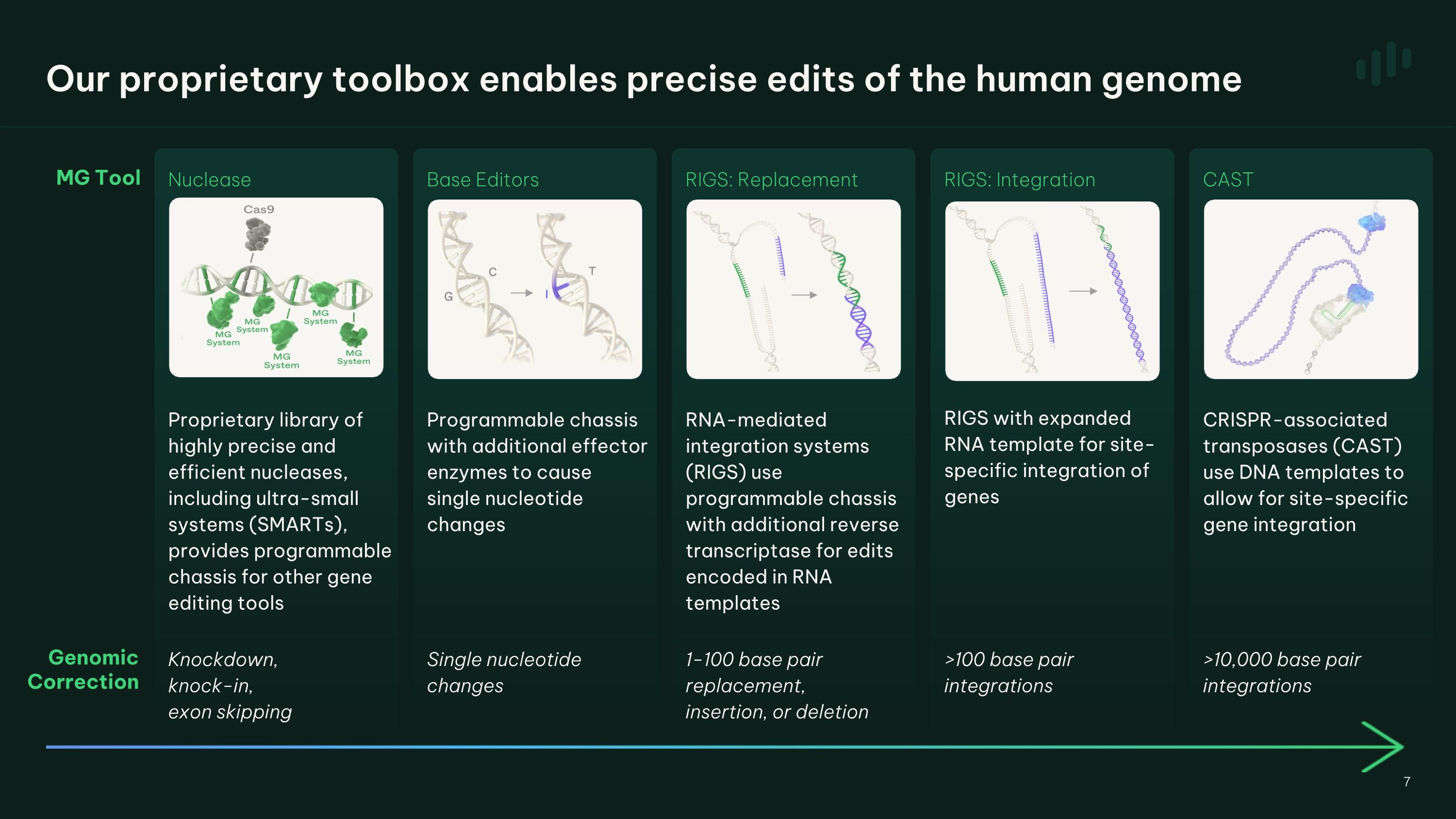
Our proprietary toolbox enables precise edits of the human genome Programmable chassis with additional effector enzymes to cause single nucleotide changes Knockdown, knock-in, exon skipping Single nucleotide changes Proprietary library of highly precise and efficient nucleases, including ultra-small systems (SMARTs), provides programmable chassis for other gene editing tools RNA-mediated integration systems (RIGS) use programmable chassis with additional reverse transcriptase for edits encoded in RNA templates 1-100 base pair replacement, insertion, or deletion >100 base pair integrations RIGS with expanded RNA template for site-specific integration of genes >10,000 base pair integrations CRISPR-associated transposases (CAST) use DNA templates to allow for site-specific gene integration Genomic Correction MG Tool Base Editors RIGS: Replacement RIGS: Integration CAST Nuclease
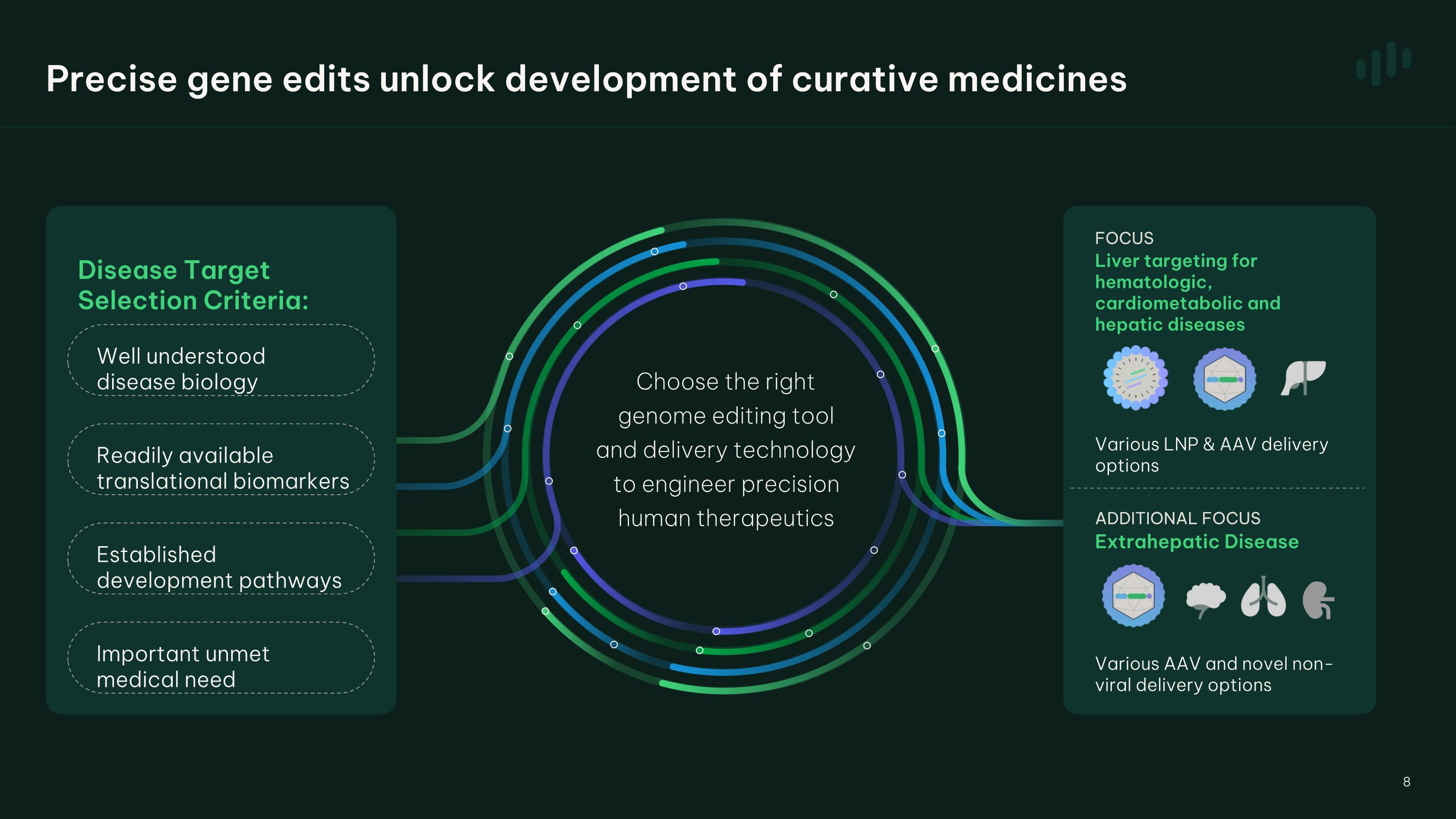
Pipeline comprised of disease targets with: Metagenomi Translation Engine Disease Target Selection Criteria: FOCUS Liver targeting for hematologic, cardiometabolic and hepatic diseases Various LNP & AAV delivery options ADDITIONAL FOCUS Extrahepatic Disease Various AAV and novel non-viral delivery options Choose the right genome editing tool and delivery technology to engineer precision human therapeutics Well understood disease biology Readily available translational biomarkers Established development pathways Important unmet medical need Precise gene edits unlock development of curative medicines
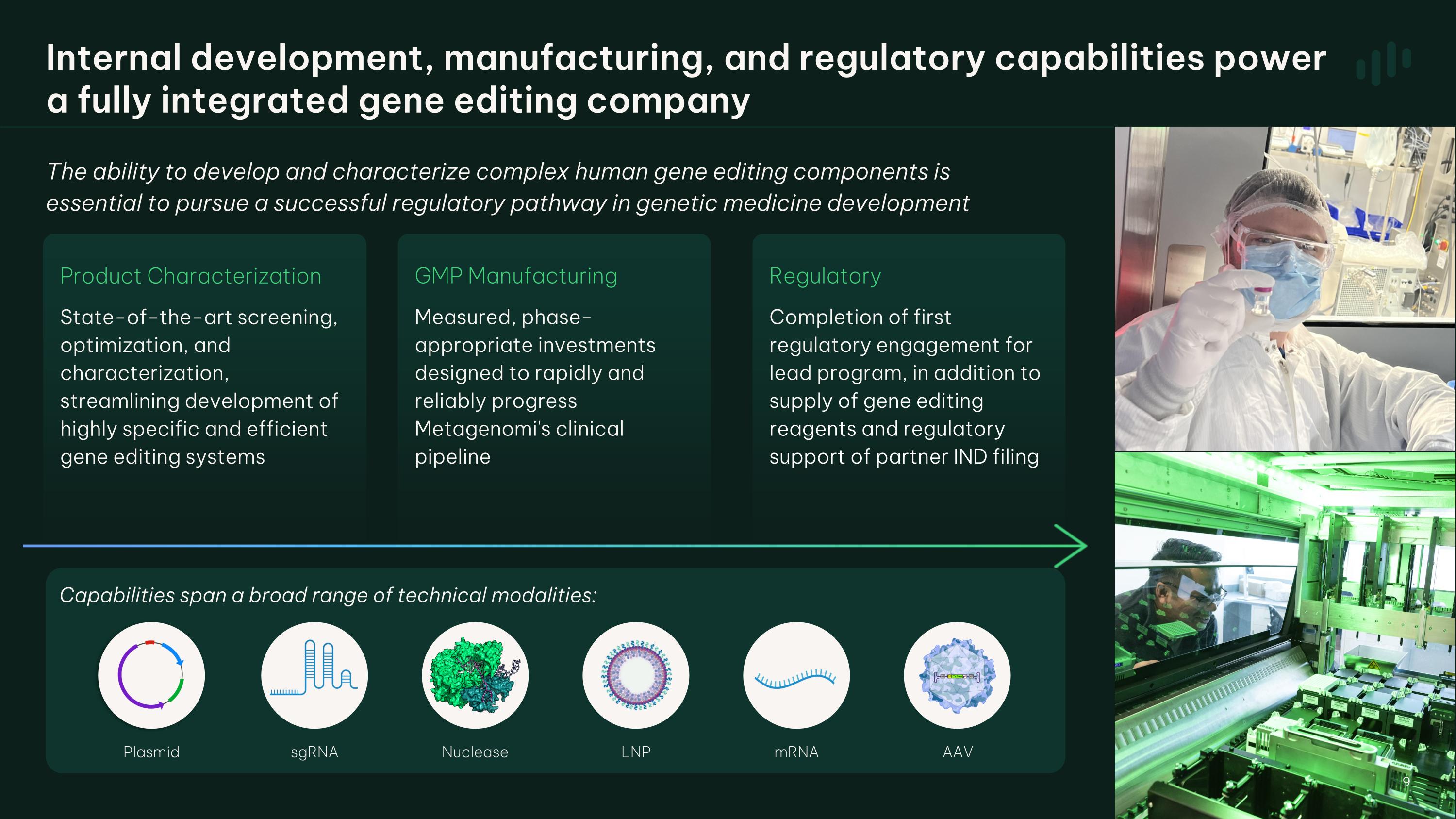
Measured, phase-appropriate investments in development and GMP manufacturing designed to rapidly and reliably progress development and manufacturing for Metagenomi’s development and clinical pipeline Product Characterization State-of-the-art screening, optimization, and characterization, streamlining development of highly specific and efficient gene editing systems GMP Manufacturing Measured, phase- appropriate investments designed to rapidly and reliably progress Metagenomi's clinical pipeline Regulatory Completion of first regulatory engagement for lead program, in addition to supply of gene editing reagents and regulatory support of partner IND filing The ability to develop and characterize complex human gene editing components is essential to pursue a successful regulatory pathway in genetic medicine development Plasmid mRNA sgRNA LNP AAV Nuclease Corporate Overview Capabilities span a broad range of technical modalities: Internal development, manufacturing, and regulatory capabilities power a fully integrated gene editing company
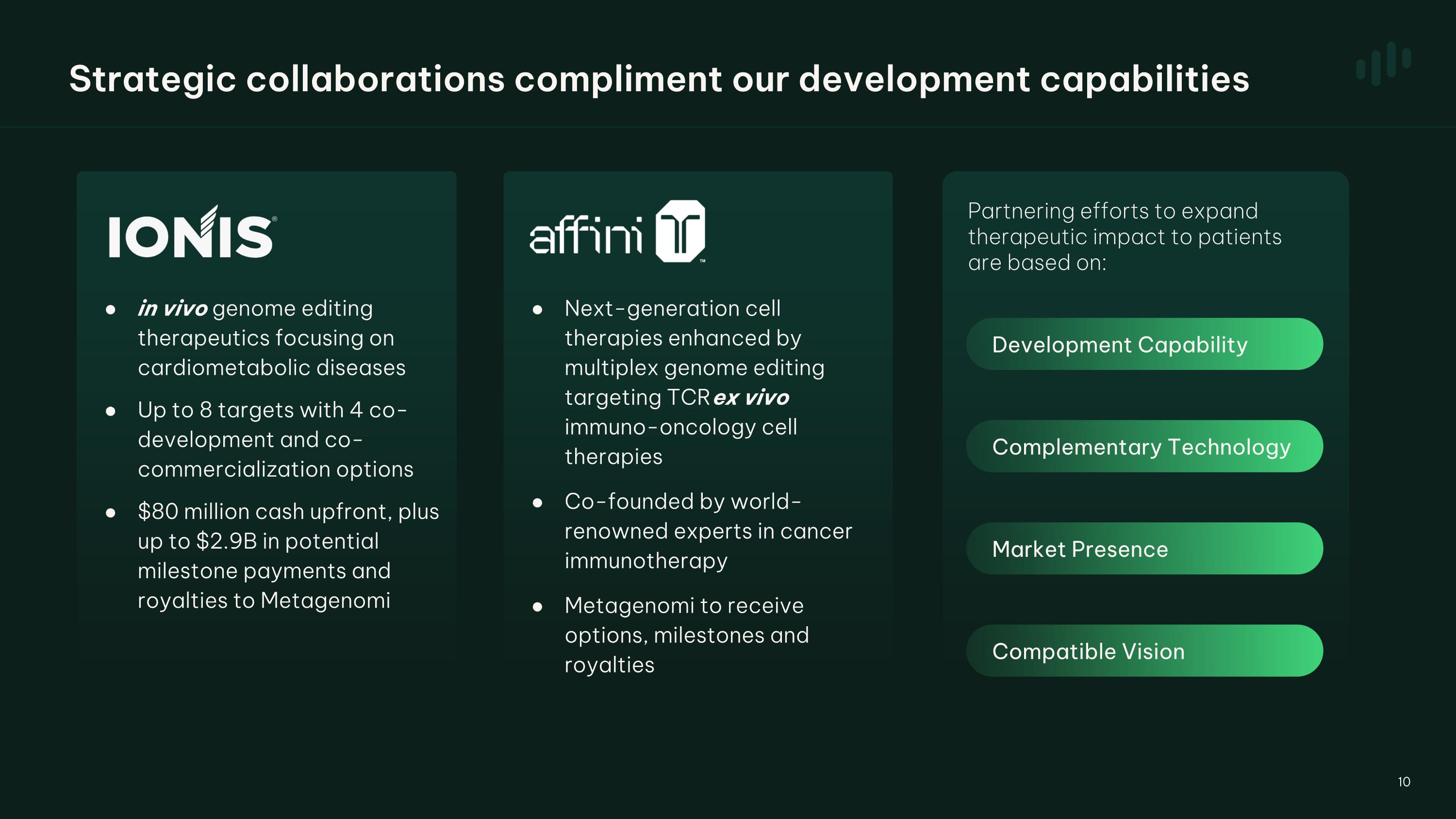
Strategic collaborations compliment our development capabilities Next-generation cell therapies enhanced by multiplex genome editing targeting TCR ex vivo immuno-oncology cell therapies Co-founded by world- renowned experts in cancer immunotherapy Metagenomi to receive options, milestones and royalties in vivo genome editing therapeutics focusing on cardiometabolic diseases Up to 8 targets with 4 co-development and co-commercialization options $80 million cash upfront, plus up to $2.9B in potential milestone payments and royalties to Metagenomi Market Presence Development Capability Complementary Technology Partnering efforts to expand therapeutic impact to patients are based on: Compatible Vision
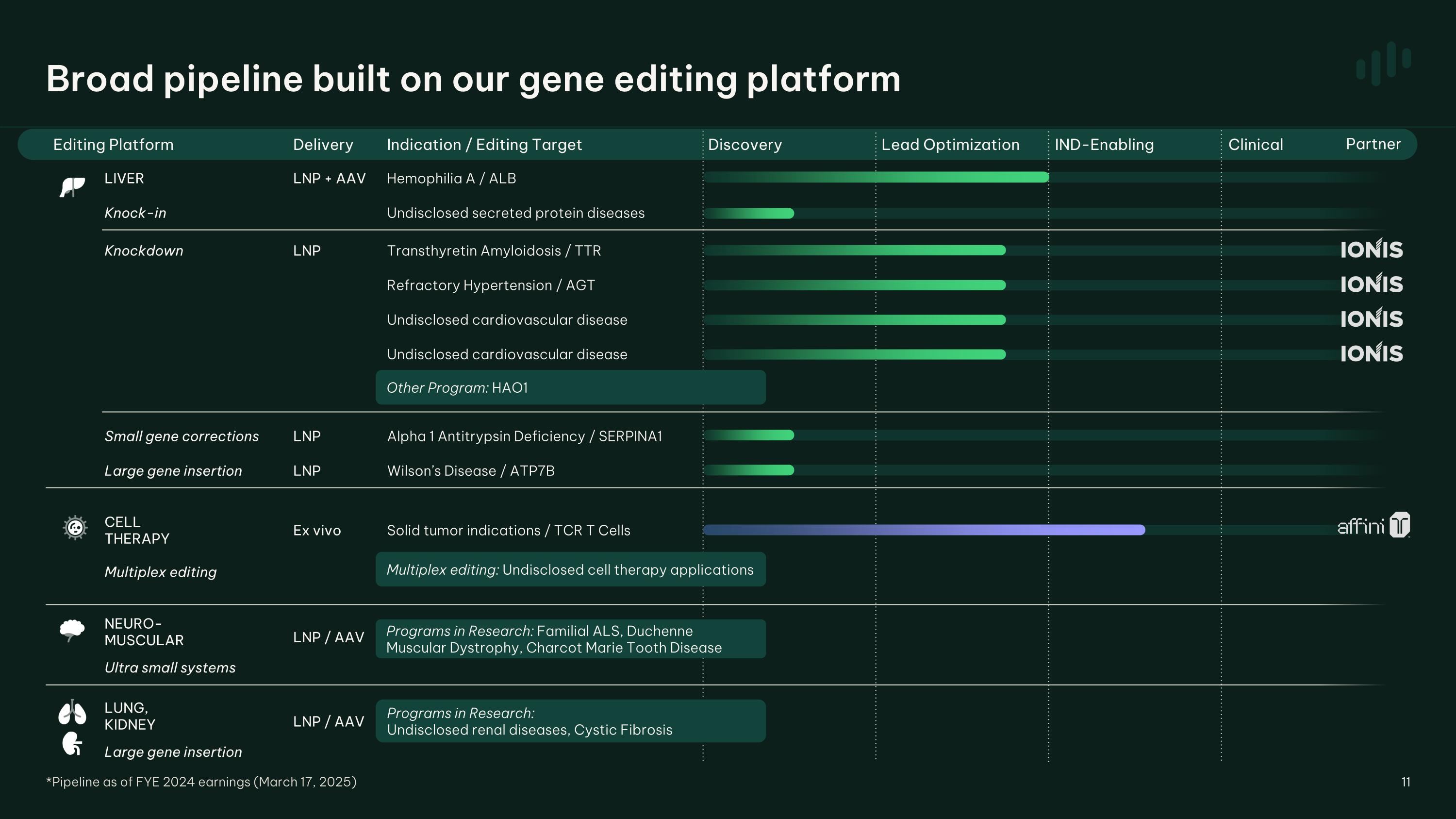
Editing Platform Delivery Indication / Editing Target Discovery Lead Optimization IND-Enabling Clinical LIVER LNP + AAV Hemophilia A / ALB Knock-in Undisclosed secreted protein diseases Knockdown LNP Transthyretin Amyloidosis / TTR Refractory Hypertension / AGT Undisclosed cardiovascular disease Undisclosed cardiovascular disease Small gene corrections LNP Alpha 1 Antitrypsin Deficiency / SERPINA1 Large gene insertion LNP Wilson’s Disease / ATP7B CELL THERAPY Multiplex editing Ex vivo Solid tumor indications / TCR T Cells NEURO- MUSCULAR Ultra small systems LNP / AAV LUNG, KIDNEY Large gene insertion LNP / AAV *Pipeline as of FYE 2024 earnings (March 17, 2025) 11 Partner Programs in Research: Familial ALS, Duchenne Muscular Dystrophy, Charcot Marie Tooth Disease Programs in Research: Undisclosed renal diseases, Cystic Fibrosis Multiplex editing: Undisclosed cell therapy applications Other Program: HAO1 Broad pipeline built on our gene editing platform 11
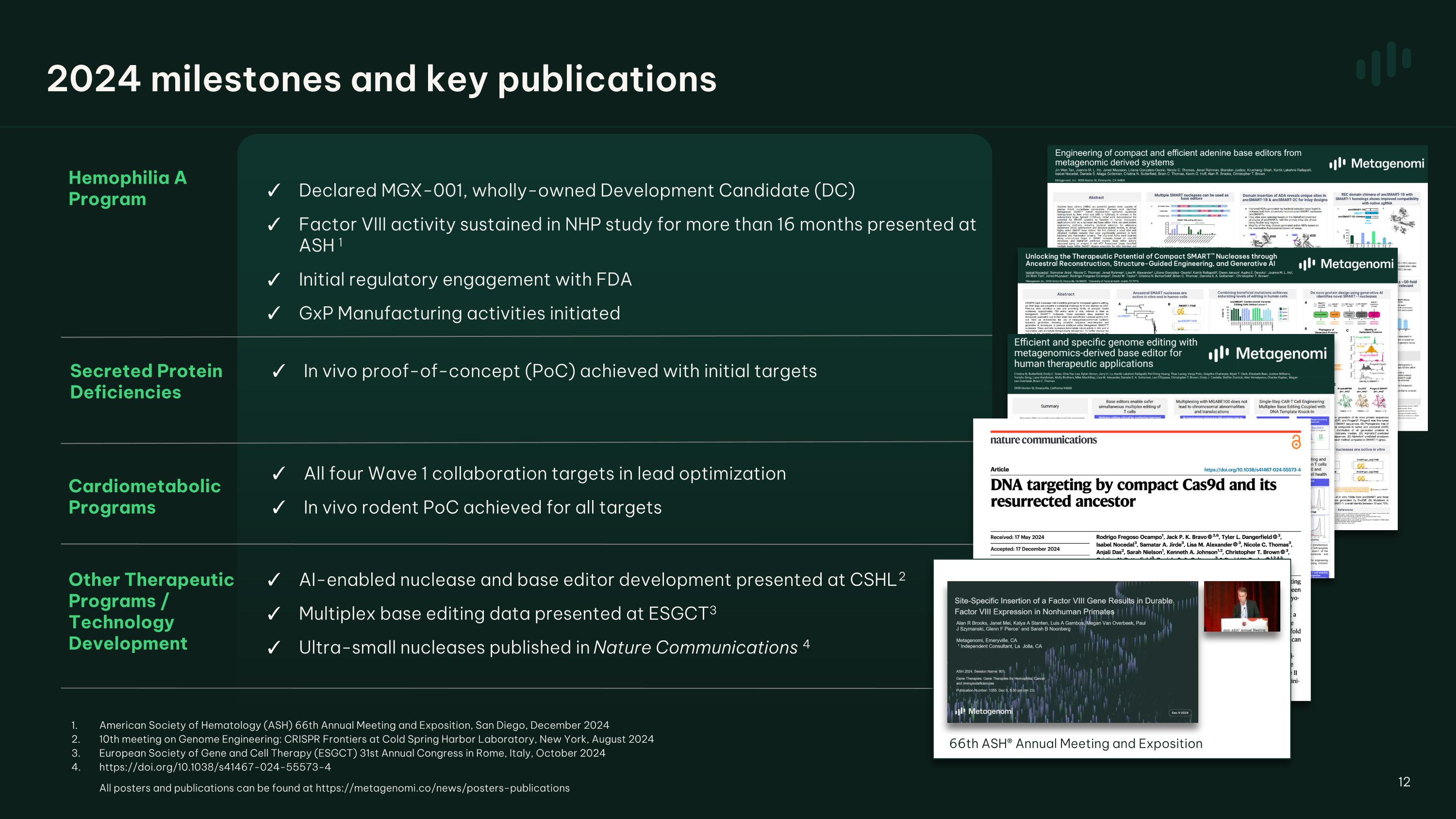
Hemophilia A Program Cardiometabolic Programs Other Therapeutic Programs / Technology Development Declared MGX-001, wholly-owned Development Candidate (DC) Factor VIII activity sustained in NHP study for more than 16 months presented at ASH 1 Initial regulatory engagement with FDA GxP Manufacturing activities initiated AI-enabled nuclease and base editor development presented at CSHL 2 Multiplex base editing data presented at ESGCT 3 Ultra-small nucleases published in Nature Communications 4 All four Wave 1 collaboration targets in lead optimization In vivo rodent PoC achieved for all targets 12 2024 milestones and key publications In vivo proof-of-concept (PoC) achieved with initial targets Secreted Protein Deficiencies American Society of Hematology (ASH) 66th Annual Meeting and Exposition, San Diego, December 2024 10th meeting on Genome Engineering: CRISPR Frontiers at Cold Spring Harbor Laboratory, New York, August 2024 European Society of Gene and Cell Therapy (ESGCT) 31st Annual Congress in Rome, Italy, October 2024 https://doi.org/10.1038/s41467-024-55573-4 All posters and publications can be found at https://metagenomi.co/news/posters-publications 66th ASH® Annual Meeting and Exposition
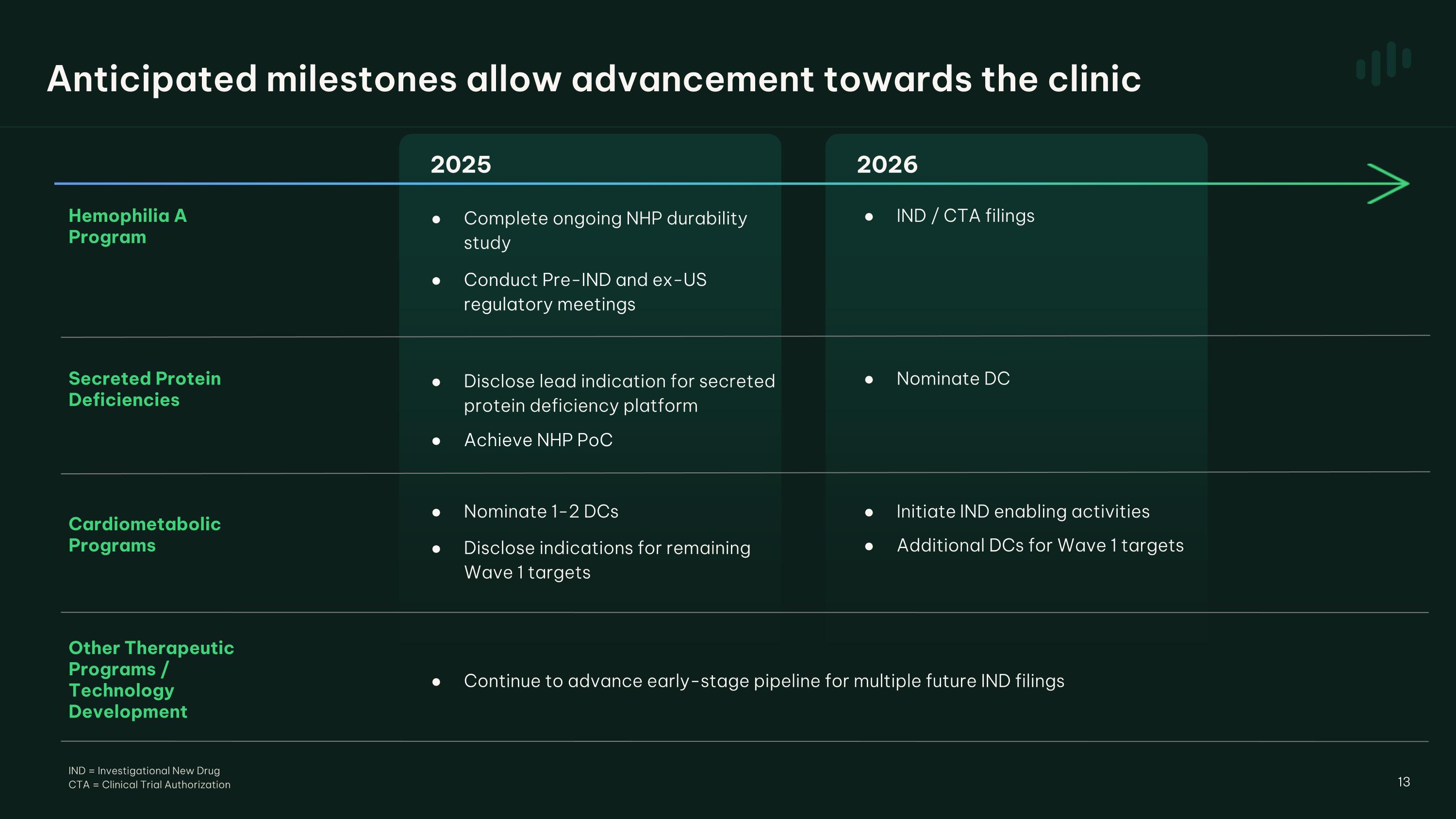
2025 2026 Hemophilia A Program Complete ongoing NHP durability study Conduct Pre-IND and ex-US regulatory meetings IND / CTA filings Cardiometabolic Programs Other Therapeutic Programs / Technology Development Continue to advance early-stage pipeline for multiple future IND filings Nominate 1-2 DCs Disclose indications for remaining Wave 1 targets Initiate IND enabling activities Additional DCs for Wave 1 targets 13 Anticipated milestones allow advancement towards the clinic Nominate DC Disclose lead indication for secreted protein deficiency platform Achieve NHP PoC Secreted Protein Deficiencies IND = Investigational New Drug CTA = Clinical Trial Authorization

Pipeline Overview 14
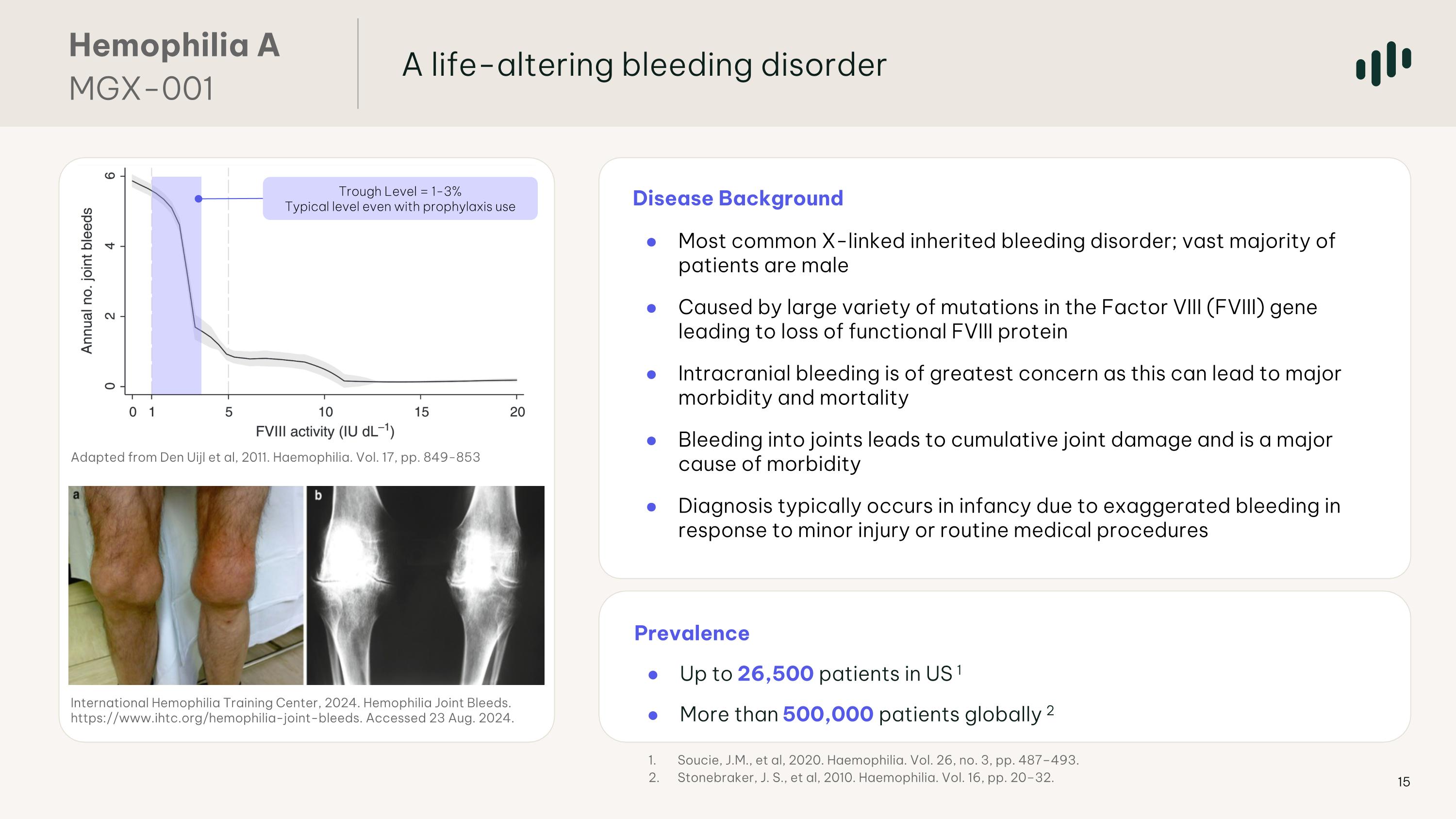
Disease Background Most common X-linked inherited bleeding disorder; vast majority of patients are male Caused by large variety of mutations in the Factor VIII (FVIII) gene leading to loss of functional FVIII protein Intracranial bleeding is of greatest concern as this can lead to major morbidity and mortality Bleeding into joints leads to cumulative joint damage and is a major cause of morbidity Diagnosis typically occurs in infancy due to exaggerated bleeding in response to minor injury or routine medical procedures Prevalence Up to 26,500 patients in US 1 More than 500,000 patients globally 2 International Hemophilia Training Center, 2024. Hemophilia Joint Bleeds. https://www.ihtc.org/hemophilia-joint-bleeds. Accessed 23 Aug. 2024. Adapted from Den Uijl et al, 2011. Haemophilia. Vol. 17, pp. 849-853 Trough Level = 1-3% Typical level even with prophylaxis use Soucie, J.M., et al, 2020. Haemophilia. Vol. 26, no. 3, pp. 487–493. Stonebraker, J. S., et al, 2010. Haemophilia. Vol. 16, pp. 20–32. A life-altering bleeding disorder Hemophilia A MGX-001
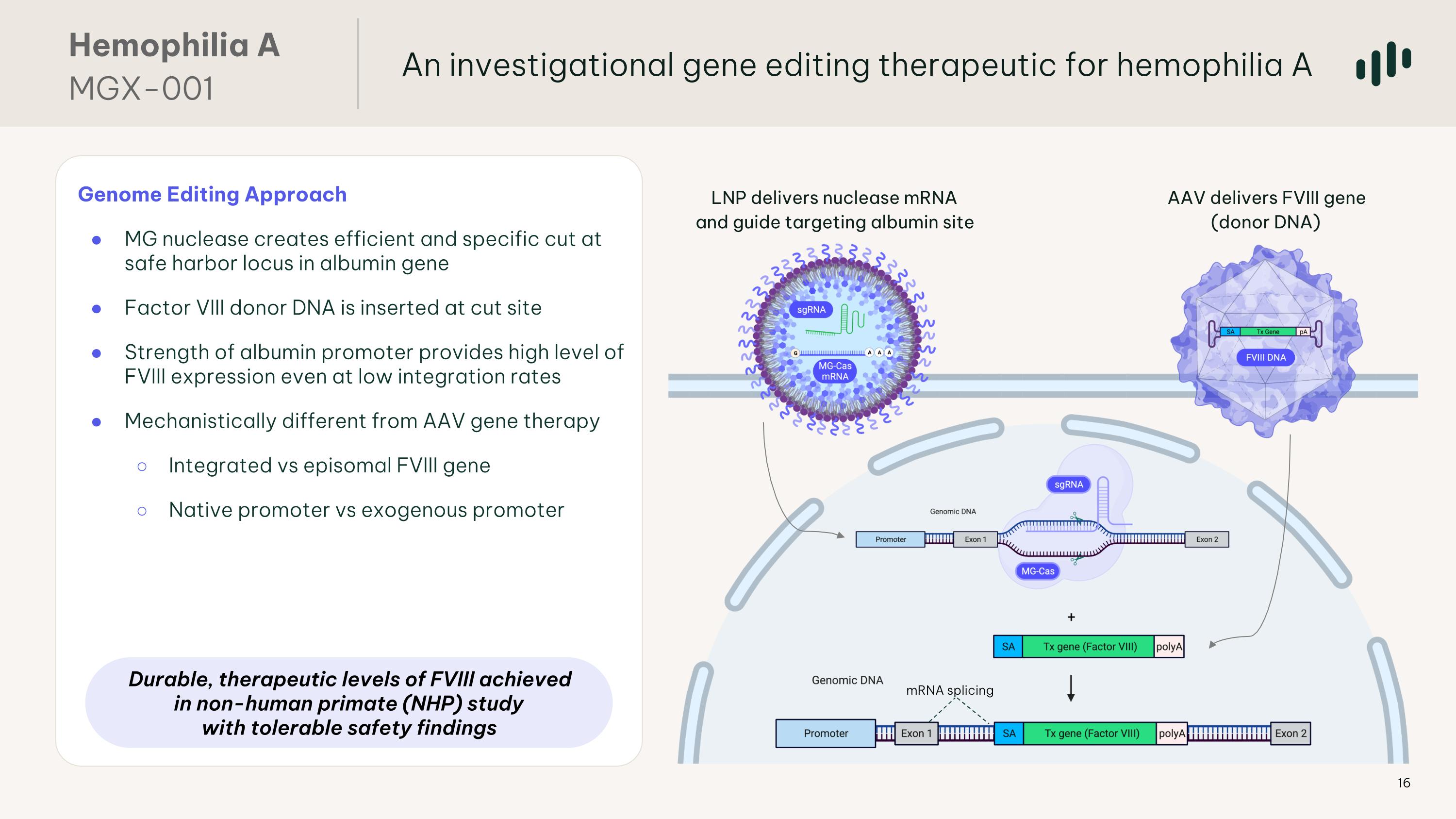
Genome Editing Approach MG nuclease creates efficient and specific cut at safe harbor locus in albumin gene Factor VIII donor DNA is inserted at cut site Strength of albumin promoter provides high level of FVIII expression even at low integration rates Mechanistically different from AAV gene therapy Integrated vs episomal FVIII gene Native promoter vs exogenous promoter An investigational gene editing therapeutic for hemophilia A Hemophilia A MGX-001 AAV delivers FVIII gene (donor DNA) LNP delivers nuclease mRNA and guide targeting albumin site mRNA splicing Durable, therapeutic levels of FVIII achieved in non-human primate (NHP) study with tolerable safety findings
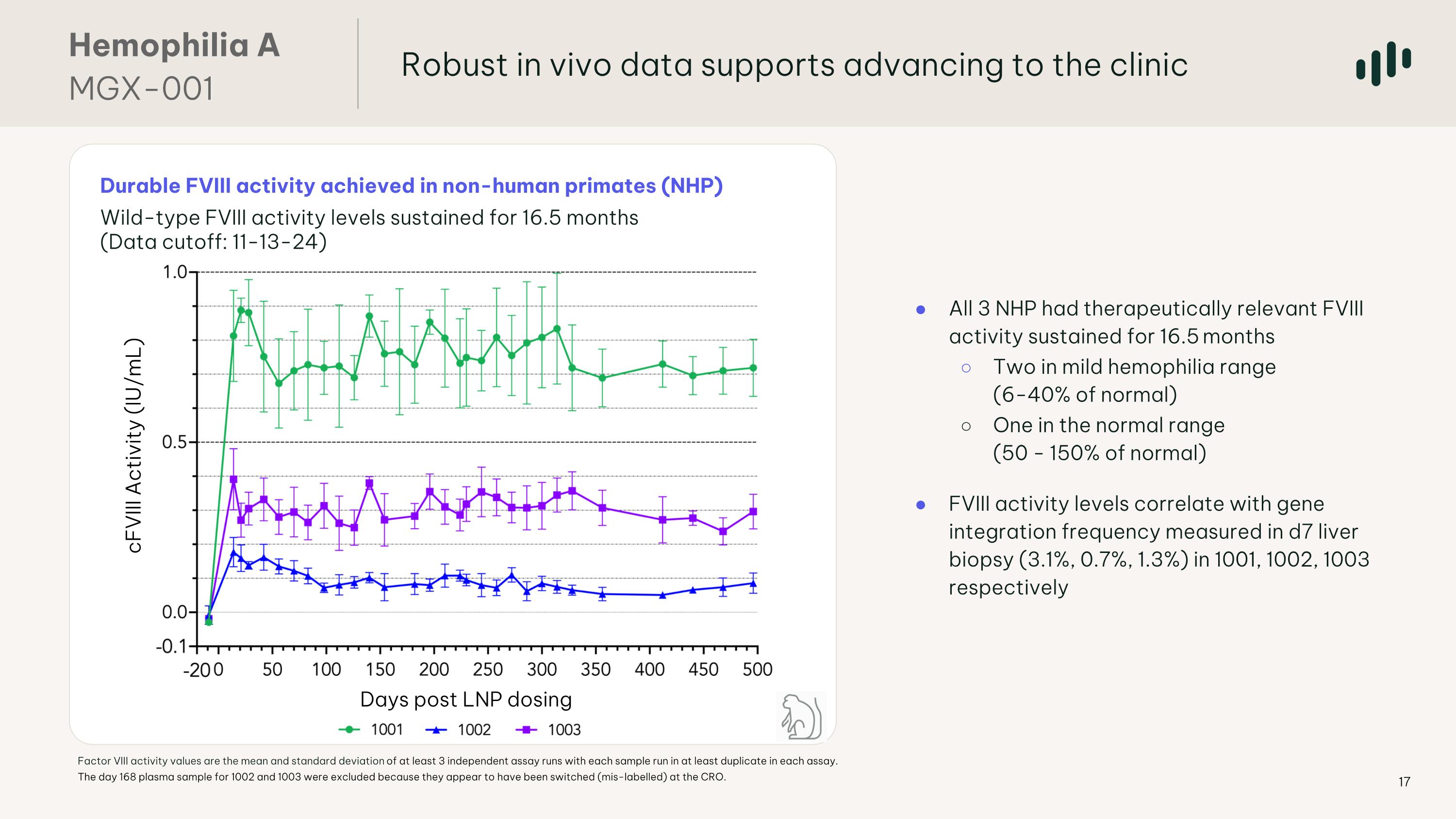
Robust in vivo data supports advancing to the clinic Durable FVIII activity achieved in non-human primates (NHP) Wild-type FVIII activity levels sustained for 16.5 months (Data cutoff: 11-13-24) Days post LNP dosing cFVIII Activity (IU/mL) Factor VIII activity values are the mean and standard deviation of at least 3 independent assay runs with each sample run in at least duplicate in each assay. The day 168 plasma sample for 1002 and 1003 were excluded because they appear to have been switched (mis-labelled) at the CRO. All 3 NHP had therapeutically relevant FVIII activity sustained for 16.5 months Two in mild hemophilia range (6-40% of normal) One in the normal range (50 - 150% of normal) FVIII activity levels correlate with gene integration frequency measured in d7 liver biopsy (3.1%, 0.7%, 1.3%) in 1001, 1002, 1003 respectively Hemophilia A MGX-001
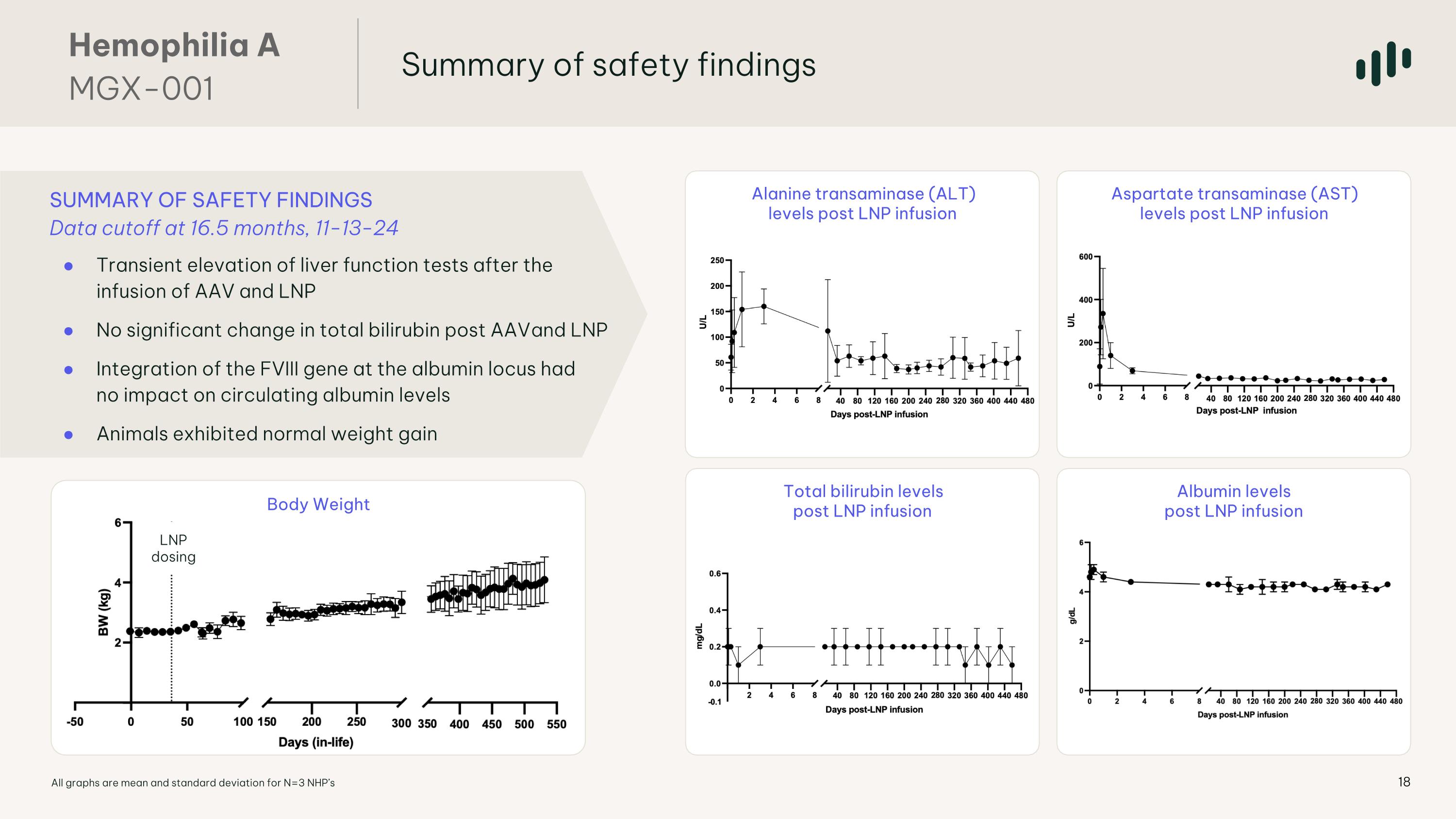
SUMMARY OF SAFETY FINDINGS Data cutoff at 16.5 months, 11-13-24 Transient elevation of liver function tests after the infusion of AAV and LNP No significant change in total bilirubin post AAV and LNP Integration of the FVIII gene at the albumin locus had no impact on circulating albumin levels Animals exhibited normal weight gain Aspartate transaminase (AST) levels post LNP infusion Total bilirubin levels post LNP infusion Alanine transaminase (ALT) levels post LNP infusion Albumin levels post LNP infusion Body Weight All graphs are mean and standard deviation for N=3 NHP’s LNP dosing Summary of safety findings Hemophilia A MGX-001
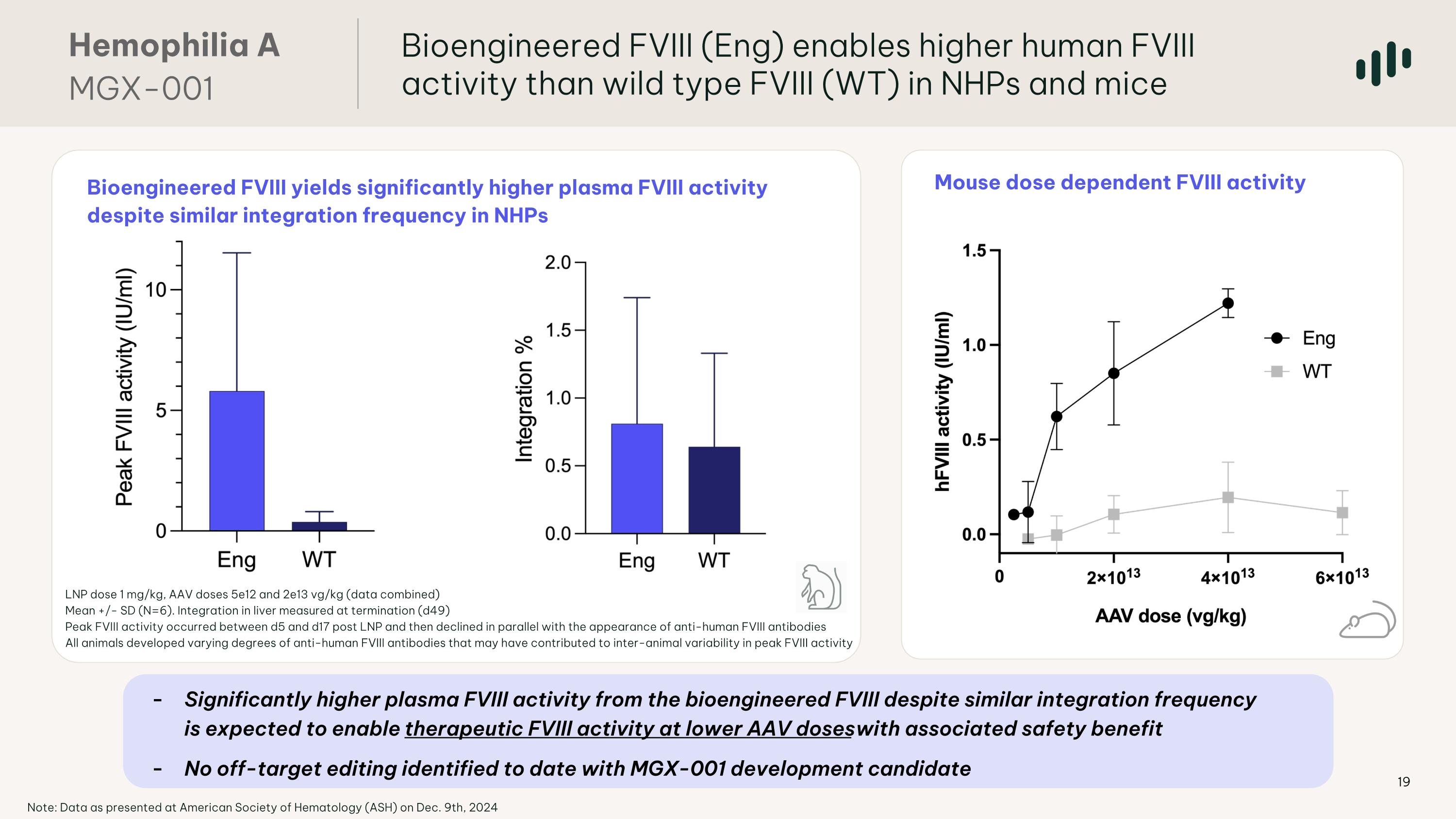
Bioengineered FVIII yields significantly higher plasma FVIII activity despite similar integration frequency in NHPs Significantly higher plasma FVIII activity from the bioengineered FVIII despite similar integration frequency is expected to enable therapeutic FVIII activity at lower AAV doses with associated safety benefit No off-target editing identified to date with MGX-001 development candidate LNP dose 1 mg/kg, AAV doses 5e12 and 2e13 vg/kg (data combined) Mean +/- SD (N=6). Integration in liver measured at termination (d49) Peak FVIII activity occurred between d5 and d17 post LNP and then declined in parallel with the appearance of anti-human FVIII antibodies All animals developed varying degrees of anti-human FVIII antibodies that may have contributed to inter-animal variability in peak FVIII activity Bioengineered FVIII (Eng) enables higher human FVIII activity than wild type FVIII (WT) in NHPs and mice Mouse dose dependent FVIII activity Note: Data as presented at American Society of Hematology (ASH) on Dec. 9th, 2024 Hemophilia A MGX-001
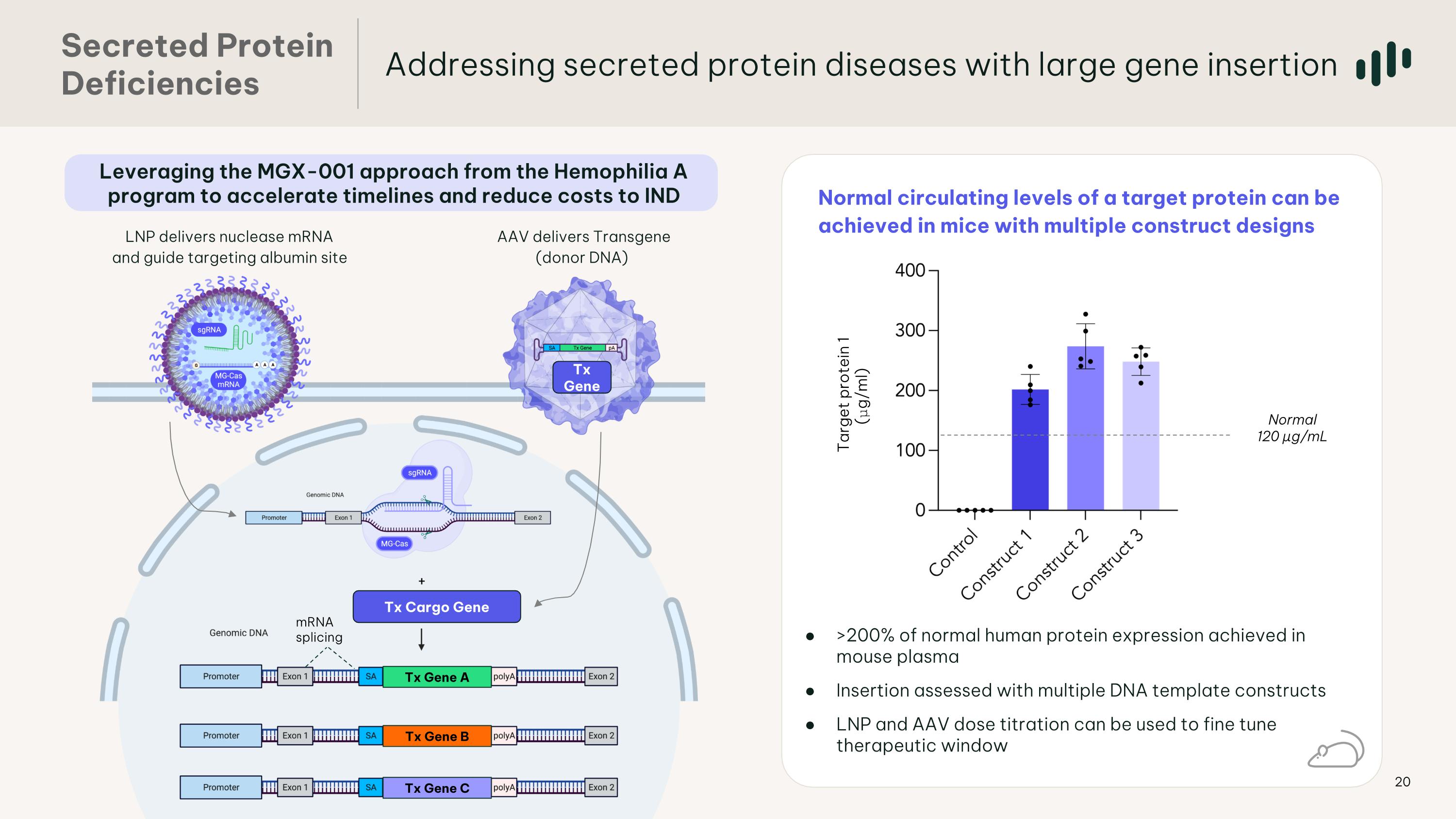
Addressing secreted protein diseases with large gene insertion Secreted Protein Deficiencies mRNA splicing Tx Gene Tx Gene A Tx Gene B Tx Gene C Tx Gene A Tx Cargo Gene Leveraging the MGX-001 approach from the Hemophilia A program to accelerate timelines and reduce costs to IND AAV delivers Transgene (donor DNA) LNP delivers nuclease mRNA and guide targeting albumin site Normal circulating levels of a target protein can be achieved in mice with multiple construct designs Normal 120 µg/mL >200% of normal human protein expression achieved in mouse plasma Insertion assessed with multiple DNA template constructs LNP and AAV dose titration can be used to fine tune therapeutic window Target protein 1 (μg/ml)
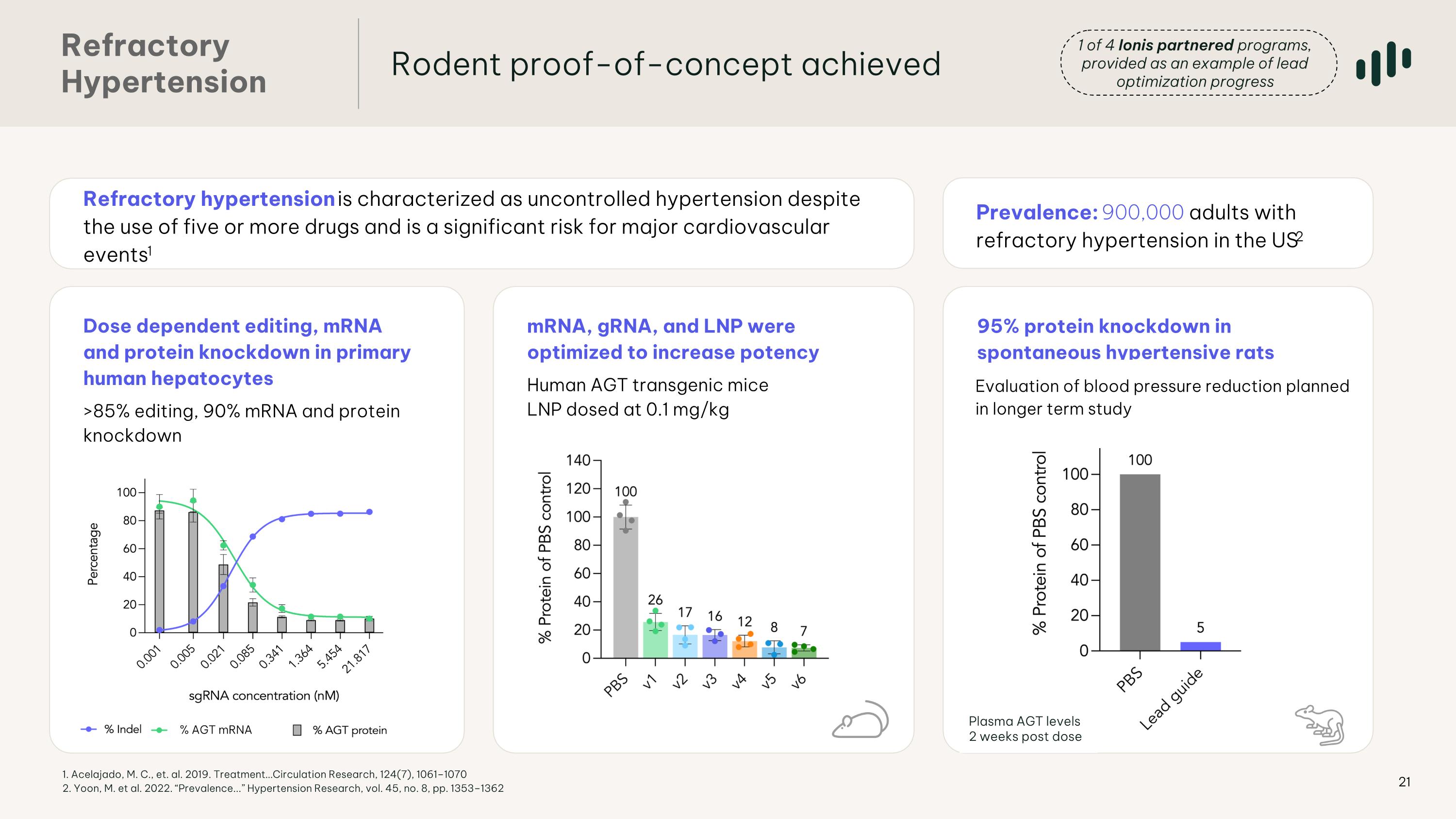
Prevalence: 900,000 adults with refractory hypertension in the US2 95% protein knockdown in spontaneous hypertensive rats Dose dependent editing, mRNA and protein knockdown in primary human hepatocytes >85% editing, 90% mRNA and protein knockdown Refractory Hypertension Rodent proof-of-concept achieved mRNA, gRNA, and LNP were optimized to increase potency Human AGT transgenic mice LNP dosed at 0.1 mg/kg Refractory hypertension is characterized as uncontrolled hypertension despite the use of five or more drugs and is a significant risk for major cardiovascular events 1 % AGT mRNA Evaluation of blood pressure reduction planned in longer term study Plasma AGT levels 2 weeks post dose 1. Acelajado, M. C., et. al. 2019. Treatment…Circulation Research, 124(7), 1061–1070 2. Yoon, M. et al. 2022. “Prevalence...” Hypertension Research, vol. 45, no. 8, pp. 1353–1362 1 of 4 Ionis partnered programs, provided as an example of lead optimization progress

22 Technology Platform
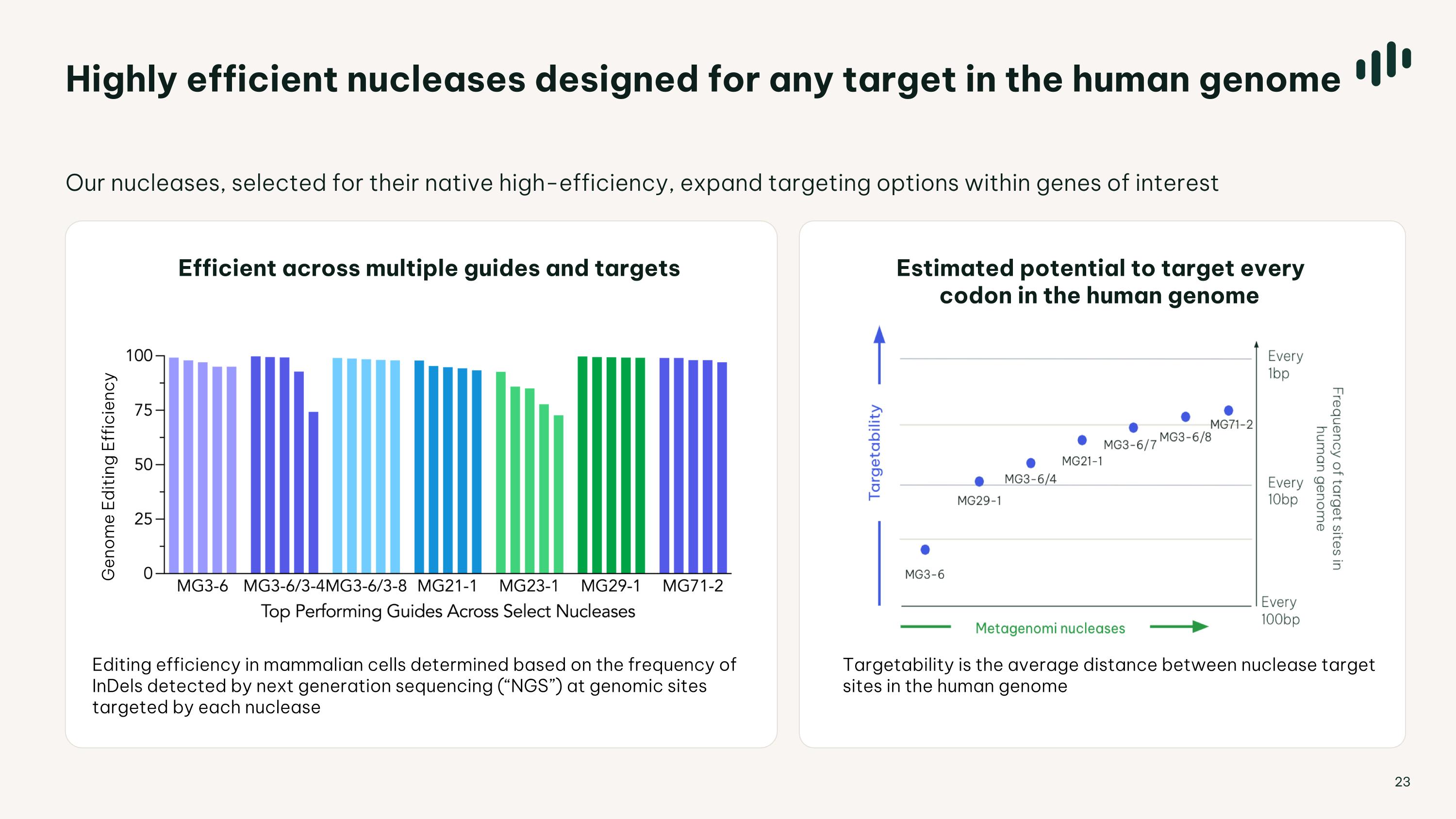
Pipeline comprised of disease targets with: Metagenomi Translation Engine Highly efficient nucleases designed for any target in the human genome 23 Editing efficiency in mammalian cells determined based on the frequency of InDels detected by next generation sequencing (“NGS”) at genomic sites targeted by each nuclease Genome Editing Efficiency Targetability is the average distance between nuclease target sites in the human genome Our nucleases, selected for their native high-efficiency, expand targeting options within genes of interest Efficient across multiple guides and targets Estimated potential to target every codon in the human genome
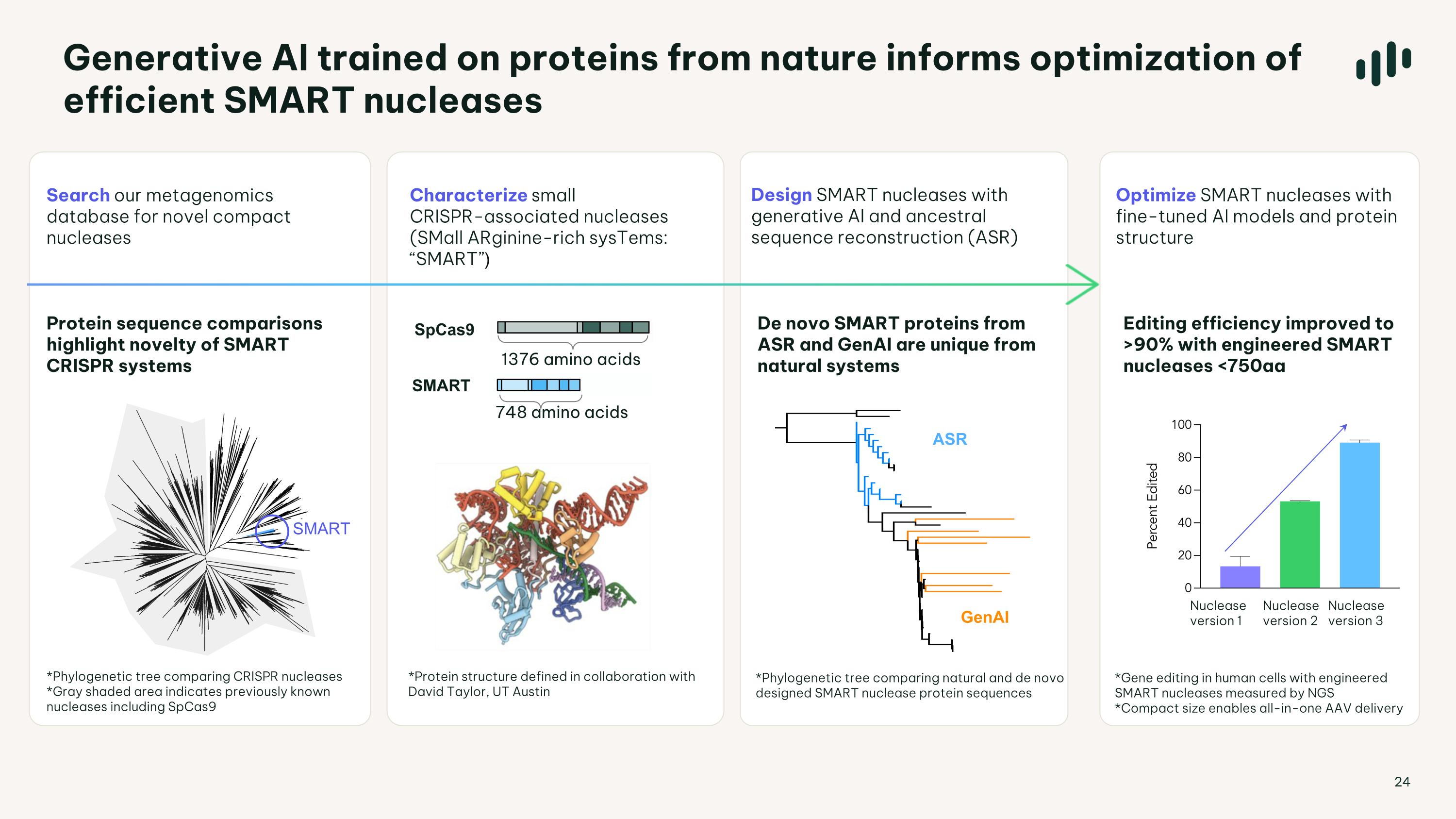
Pipeline comprised of disease targets with: Metagenomi Translation Engine Generative AI trained on proteins from nature informs optimization of efficient SMART nucleases 24 SpCas9 1376 amino acids Characterize small CRISPR-associated nucleases (SMall ARginine-rich sysTems: “SMART”) Search our metagenomics database for novel compact nucleases Optimize SMART nucleases with fine-tuned AI models and protein structure Nuclease version 1 Nuclease version 2 Nuclease version 3 Design SMART nucleases with generative AI and ancestral sequence reconstruction (ASR) *Protein structure defined in collaboration with David Taylor, UT Austin 748 amino acids SMART Protein sequence comparisons highlight novelty of SMART CRISPR systems *Phylogenetic tree comparing CRISPR nucleases *Gray shaded area indicates previously known nucleases including SpCas9 Editing efficiency improved to >90% with engineered SMART nucleases <750aa *Phylogenetic tree comparing natural and de novo designed SMART nuclease protein sequences De novo SMART proteins from ASR and GenAI are unique from natural systems ASR *Gene editing in human cells with engineered SMART nucleases measured by NGS *Compact size enables all-in-one AAV delivery GenAI SMART
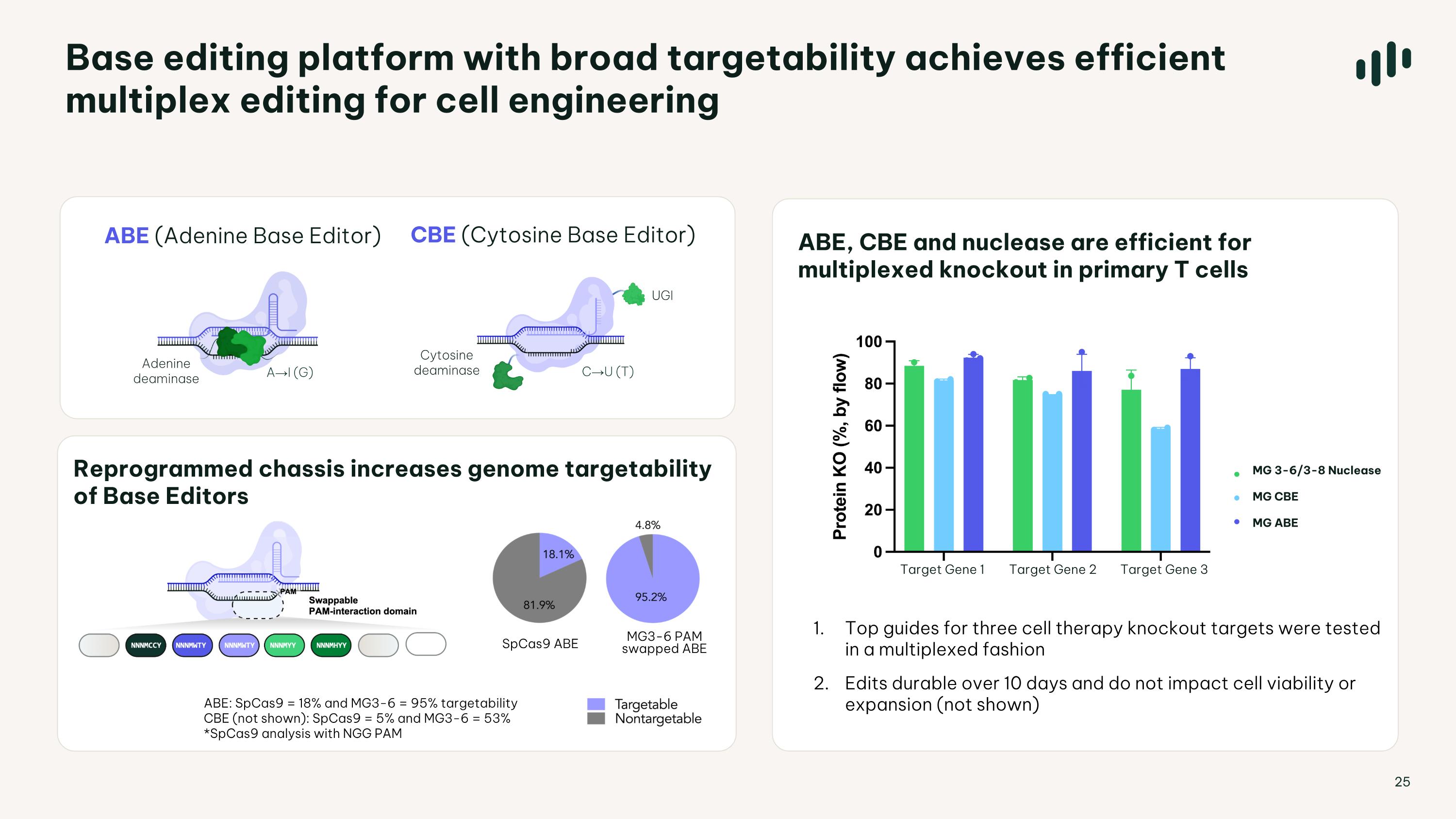
Pipeline comprised of disease targets with: Metagenomi Translation Engine Base editing platform with broad targetability achieves efficient multiplex editing for cell engineering 25 ABE, CBE and nuclease are efficient for multiplexed knockout in primary T cells Reprogrammed chassis increases genome targetability of Base Editors SpCas9 ABE MG3-6 PAM swapped ABE ABE: SpCas9 = 18% and MG3-6 = 95% targetability CBE (not shown): SpCas9 = 5% and MG3-6 = 53% *SpCas9 analysis with NGG PAM Top guides for three cell therapy knockout targets were tested in a multiplexed fashion Edits durable over 10 days and do not impact cell viability or expansion (not shown) ABE (Adenine Base Editor) Adenine deaminase CBE (Cytosine Base Editor) UGI Cytosine deaminase C→U (T) A→I (G) Target Gene 1 Target Gene 2 Target Gene 3 MG 3-6/3-8 Nuclease MG CBE MG ABE
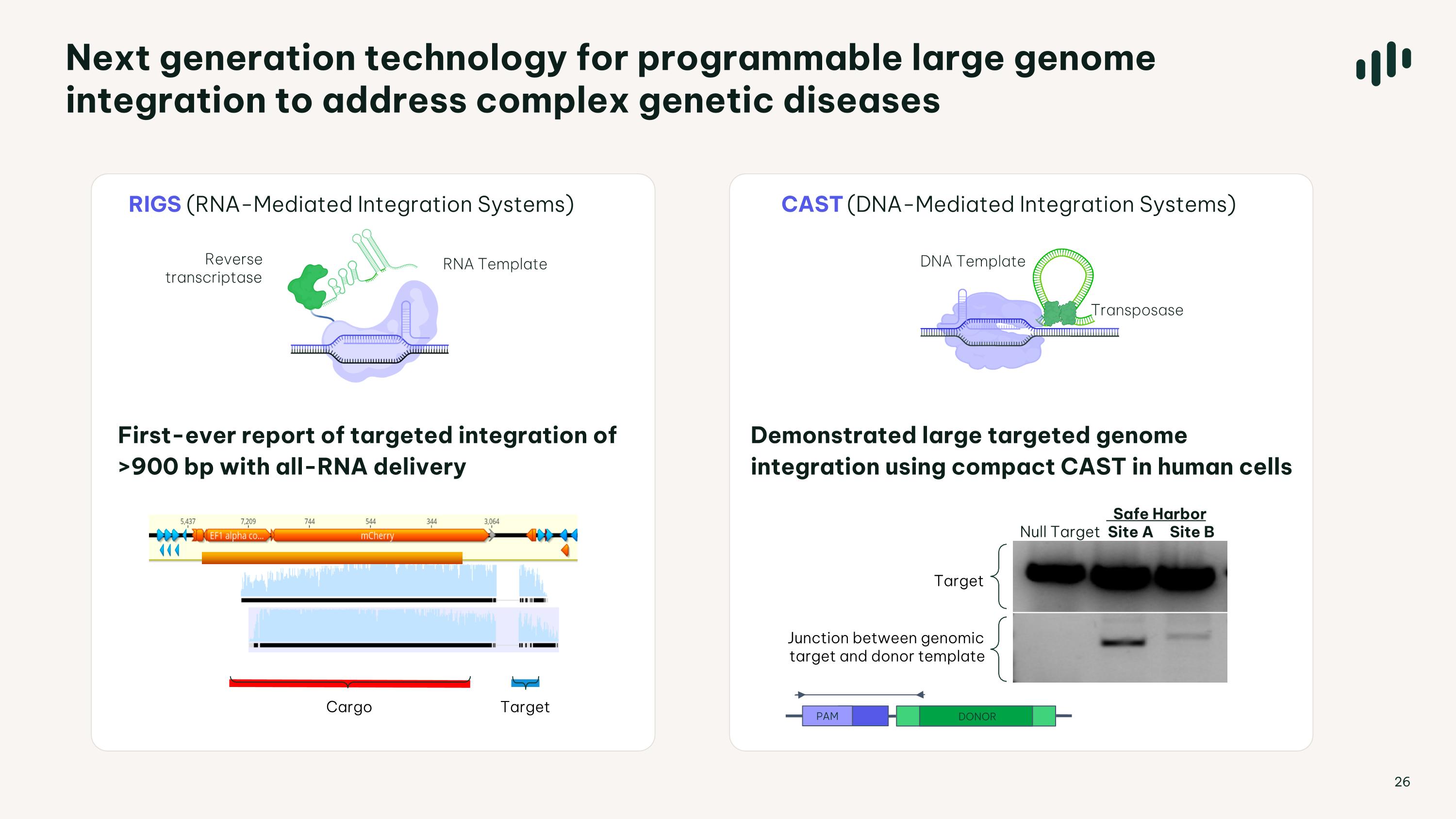
Pipeline comprised of disease targets with: Metagenomi Translation Engine Next generation technology for programmable large genome integration to address complex genetic diseases 26 CAST (DNA-Mediated Integration Systems) DNA Template Transposase CAST (DNA-Mediated Integration Systems) DNA Template Transposase Junction between genomic target and donor template Target Null Target Site A Site B Demonstrated large targeted genome integration using compact CAST in human cells RIGS (RNA-Mediated Integration Systems) Reverse transcriptase RNA Template Cargo Target First-ever report of targeted integration of >900 bp with all-RNA delivery DONOR PAM Safe Harbor
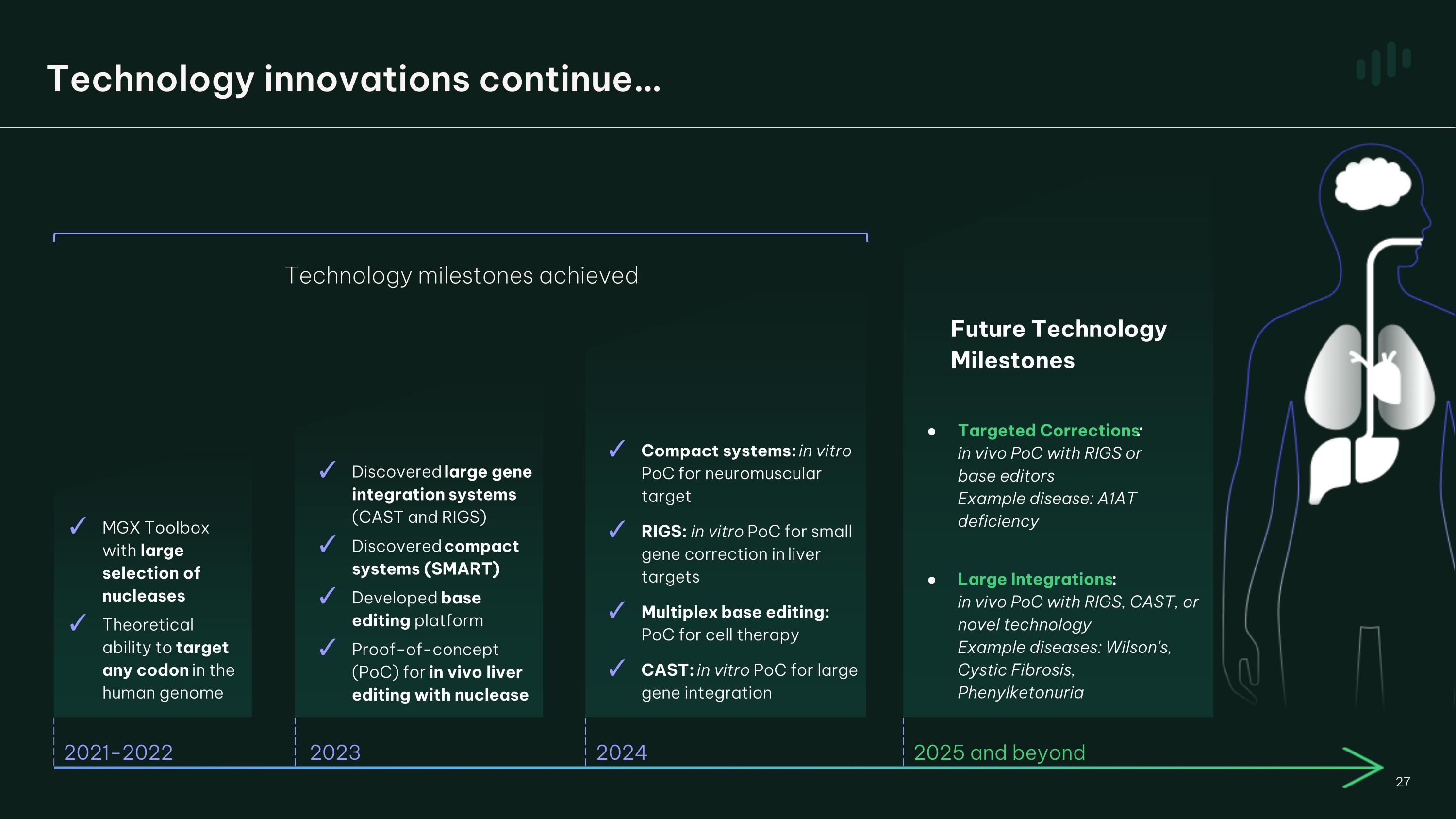
27 2021-2022 Discovered large gene integration systems (CAST and RIGS) Discovered compact systems (SMART) Developed base editing platform Proof-of-concept (PoC) for in vivo liver editing with nuclease 2023 2024 2025 and beyond Compact systems: in vitro PoC for neuromuscular target RIGS: in vitro PoC for small gene correction in liver targets Multiplex base editing: PoC for cell therapy CAST: in vitro PoC for large gene integration Targeted Corrections: in vivo PoC with RIGS or base editors Example disease: A1AT deficiency Large Integrations: in vivo PoC with RIGS, CAST, or novel technology Example diseases: Wilson's, Cystic Fibrosis, Phenylketonuria MGX Toolbox with large selection of nucleases Theoretical ability to target any codon in the human genome Technology milestones achieved Future Technology Milestones Technology innovations continue…

28 Corporate Highlights
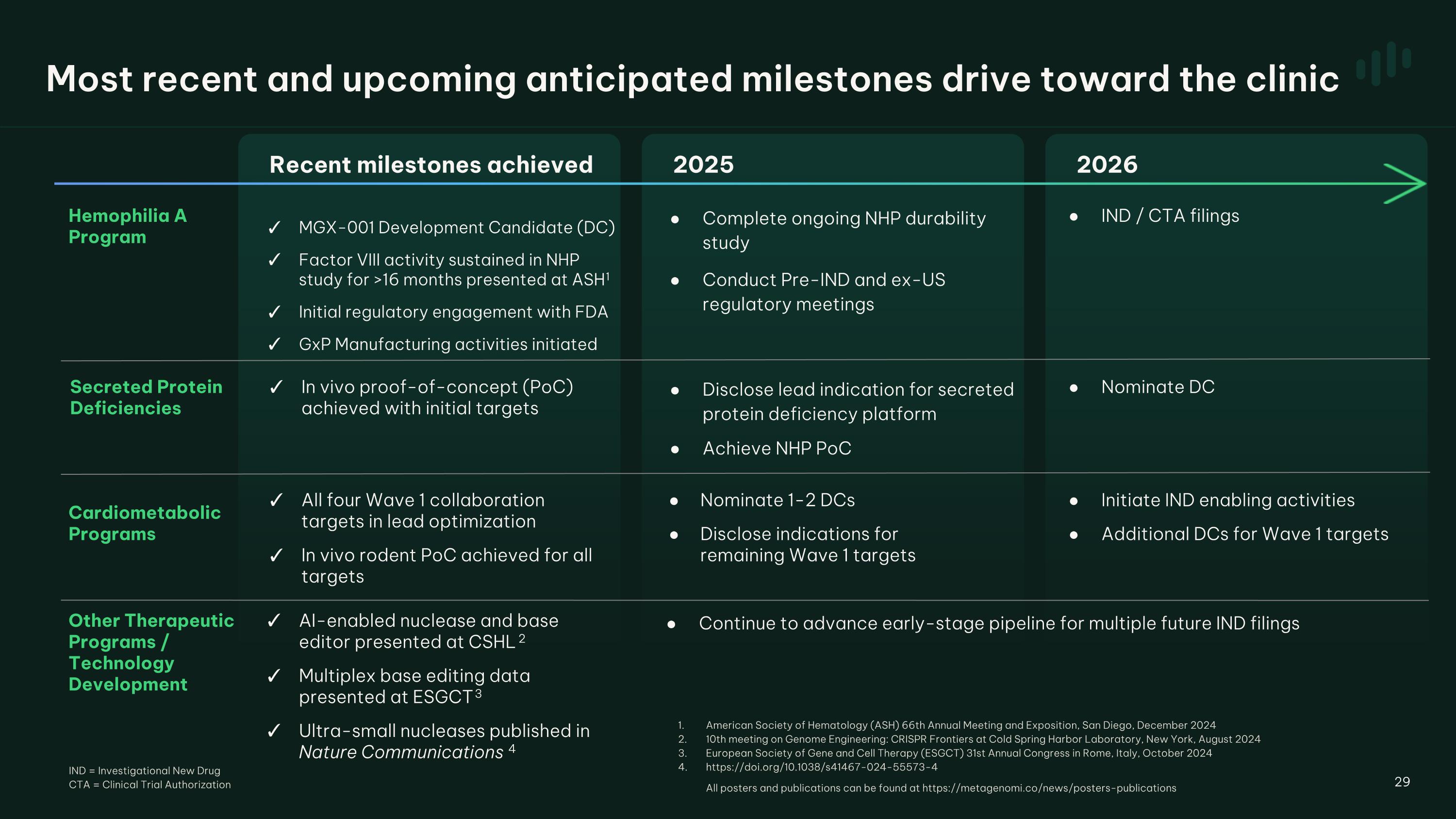
Recent milestones achieved 2025 2026 Hemophilia A Program Complete ongoing NHP durability study Conduct Pre-IND and ex-US regulatory meetings IND / CTA filings Cardiometabolic Programs Other Therapeutic Programs / Technology Development MGX-001 Development Candidate (DC) Factor VIII activity sustained in NHP study for >16 months presented at ASH 1 Initial regulatory engagement with FDA GxP Manufacturing activities initiated AI-enabled nuclease and base editor presented at CSHL 2 Multiplex base editing data presented at ESGCT 3 Ultra-small nucleases published in Nature Communications 4 Nominate 1-2 DCs Disclose indications for remaining Wave 1 targets Initiate IND enabling activities Additional DCs for Wave 1 targets All four Wave 1 collaboration targets in lead optimization In vivo rodent PoC achieved for all targets 29 Most recent and upcoming anticipated milestones drive toward the clinic In vivo proof-of-concept (PoC) achieved with initial targets Nominate DC Disclose lead indication for secreted protein deficiency platform Achieve NHP PoC Secreted Protein Deficiencies IND = Investigational New Drug CTA = Clinical Trial Authorization Continue to advance early-stage pipeline for multiple future IND filings American Society of Hematology (ASH) 66th Annual Meeting and Exposition, San Diego, December 2024 10th meeting on Genome Engineering: CRISPR Frontiers at Cold Spring Harbor Laboratory, New York, August 2024 European Society of Gene and Cell Therapy (ESGCT) 31st Annual Congress in Rome, Italy, October 2024 https://doi.org/10.1038/s41467-024-55573-4 All posters and publications can be found at https://metagenomi.co/news/posters-publications
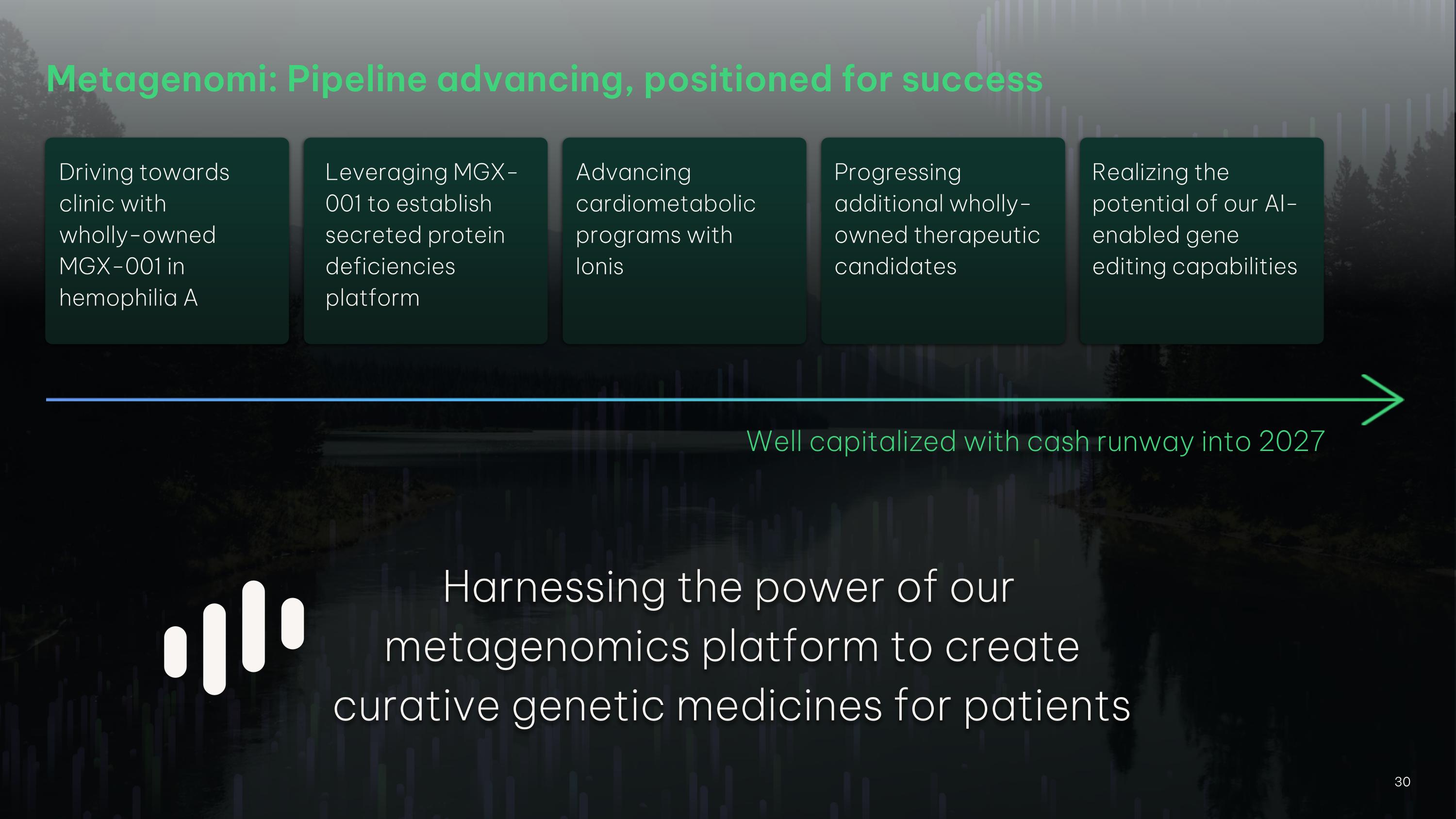
Metagenomi: Pipeline advancing, positioned for success Well capitalized with cash runway into 2027 Harnessing the power of our metagenomics platform to create curative genetic medicines for patients Advancing cardiometabolic programs with Ionis Progressing additional wholly-owned therapeutic candidates Driving towards clinic with wholly-owned MGX-001 in hemophilia A Leveraging MGX-001 to establish secreted protein deficiencies platform Realizing the potential of our AI-enabled gene editing capabilities 30

Thank you 31 Investor Contact: IR@metagenomi.co